




















Welcome to an exciting new chapter in the Asheville Symphony’s history! This marks the first full season in our new Masterworks home of First Baptist Church of Asheville. Together, we are forging a dynamic new path for this organization and our musical community.
Because of your support, the Asheville Symphony has been on an amazing growth trajectory over the last few years. Our subscriber base is surging to new heights, sponsorships and philanthropy hit record highs last season, and we are offering our widest variety of experiences to educate and delight the people of Western North Carolina.
Last year, we welcomed more than 3,300 new patrons to our concerts, and more than 44% of last year’s donor base were new donors to the organization. The Asheville Symphony Youth Orchestra, our core music education program, continues its impressive growth trend, increasing enrollment by 62%, setting new philanthropic records, and boasting higher retention rates than ever before.
I am thrilled that Music Director Darko Butorac has renewed his contract with the Asheville Symphony for three more years, which allows us to develop the artistic quality and deepen the creativity of our programming. We continue to draw top international artistic talent like Alexi Kenney and Joshua Roman. And, we are delighted to showcase the incredible talent of our own orchestra members as featured soloists this season, such as Principal Flute Lissie Shanahan.
One of our principal goals at the Asheville Symphony is to deepen our engagement with the community. To that end, our new Solo Recital Series aims to provide new ways to experience our soloists in a more intimate setting. Most excitingly, this season will see the continued expansion of the Asheville Amadeus Festival, which returns in May of 2025. This year’s Festival, co-headlined by electrifying classical trio, Time for Three, and genre-bending MacArthur Fellow Chris Thile (all GRAMMY Award winners in their own right), will bring our season to a stunning conclusion.
The bottom line: there has never been a more exciting time to be part of the Asheville Symphony community. Consider making a gift to support the Symphony’s Annual Fund and help fuel the passion and creativity that make our performances unforgettable. Invite your friends and neighbors to experience the magic of a live concert and share in the joy of music. Volunteer your time to help us continue our mission of bringing exceptional music to our community. The future of your Asheville Symphony is incredibly bright, and with your support, we can reach even greater heights together.
Please join us on this year’s thrilling journey and be a part of something truly extraordinary!

Daniel M. Crupi Executive Director
WITH EACH VISIT, AN OPPORTUNITY TO BE INSPIRED.

For over 30 years, Blue Spiral 1 has been an anchor for downtown Asheville's thriving art scene. As part of our 2024-2025 partnership with the Asheville Symphony, we're celebrating our longtime collaboration by donating 10% of gallery sales in November and February when you mention the Asheville Symphony during the time of purchase.
Experience exceptional art and support our vibrant community with Blue Spiral 1 and your Asheville Symphony. 38

Patti Quinn Hill’s basketry is rooted in traditional techniques, drawing from Shaker, Nantucket, and Native American influences. She innovatively combines these historical methods with a contemporary approach, imbuing each piece with a distinct character. Hill works with archival paper, specifically 100% cotton heavyweight paper, which is intricately woven with metallic thread lashing. The paper is painted on both sides using a variety of surface design techniques before being cut into strips and then woven into embellished baskets.

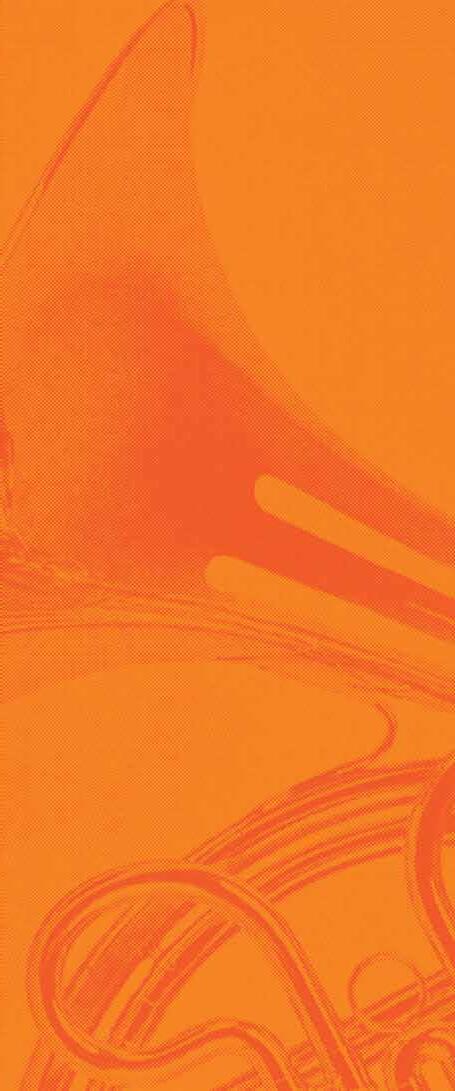



Daniel M. Crupi Executive Director
DEVELOPMENT
Sara Henley Director of Development
Madeline Womack Assistant Director of Development
Dana Alward Development Associate
EDUCATION
Tyson Hamrick ASYO General Manager
Mika Hood Operations Coordinator
MARKETING & PATRON RELATIONS
Alex Hill Director of Marketing & Patron Relations
Claire M. Allen Art Director
Melissa Starkweather Patron Relations & Communications Manager
ORCHESTRA OPERATIONS
Sally J. Keeney Orchestra Manager
Michael Di Trolio Principal Librarian
Paul Stroebel Stage Manager





That family trip you’ve been meaning to take. The home renovation you’ve always wanted to do. The career pivot you’re ready to make. All those things you said you’d do someday can start happening today. Because some things just can’t wait, and we can design your financial plan so you can feel good about going for them. Spend your life living.®

Marlowe Pasarilla Wealth Management Group MPWEALTHGROUP@NM.COM www.mpwealthgroup.com
138 Charlotte St, Ste 200 Asheville, NC 28801


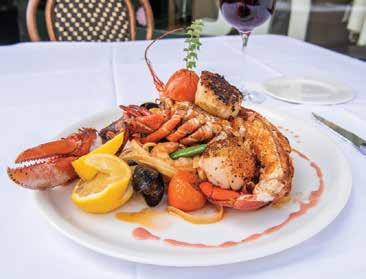




OFFICERS
Sue Luther President
Adarrell Gadsden
President-Elect
Michael Andry
Immediate Past President
Sallie Broach
Secretary
G. Edward Towson, II ⁺
Treasurer
DIRECTORS
Cliff Albertson
Jack Anderson ⁺
Michael Andry
Thomas C. Bolton ⁺
Sallie Broach
Susan Harrington Butts
Sean Comeaux
Dr. John Cuellar
George Dambach
John W. Ellis
Dr. Bolling Farmer
Adarrell Gadsden
Bill Gettys ⁺
Scott Gregg
Fred Groce
Mary Kirby
Pam Lowe-Hoyte
Sue Luther
Carol McCollum ⁺
Kevin Pasarilla
Patrick O’Cain
Jeffrey Owen
Cristian Rubiano
Richard Schaffer
Jayne Schnaars
Rachel Sossoman
James S. Thompson
G. Edward Towson, II⁺
Sarah Van Gunten
David Worley
Olivia Zahler



As I begin the second and final year of my term as President of the Asheville Symphony Board of Directors, I look back and am so grateful for all the support our wonderful Symphony has received. The Asheville Symphony has been a cornerstone of the arts in Asheville for over 60 years, and this institution is stronger than ever after our 23-24 venue adaptations. From the bottom of my heart, I want to express my deep appreciation to my fellow board members, our professional staff, the musicians, volunteers, and our wonderful patrons. We all pulled together to make our 23-24 season a resounding success!
On a personal level, I am deeply proud of our growing Music Education initiatives. Our Music in the Schools program continues to introduce the wonder of music to all 1st-4th grade students in Buncombe County and Asheville City Schools classrooms. 5th-graders experience a live, professional performance specifically curated for first-time concertgoers at our Young People’s Concerts. The Asheville Symphony Youth Orchestra engages more student musicians than ever before, providing in-depth and high quality musical training and performance experience, including the opportunity to perform alongside Symphony artists. Our Board of Directors has also organized a Music Education Committee which for the last two years has offered scholarships for promising young students to Mars Hill University’s summer band camp. This committee has also provided a musical education component to Project Lighten Up, a summer program at Rock Hill Missionary Baptist Church in Shiloh. The dedicated generosity of our board members, patrons, and donors continues to ensure that each of these education programs flourishes, engaging Western North Carolina youth in music for years to come.
I am looking forward to another exceptional and vibrant year ahead. We still have work to do to ensure that the Asheville Symphony continues to grow with our community. Together, we are united in our passion for this orchestra and in a passion for sharing the richness of classical music with new fans of all ages. Thank you to our entire community for your support.
For those who are new to the Symphony, I look forward to welcoming you in person. Please join me in celebrating the 24-25 season ahead!


George M. Bilbrey, Jr. M.D.*
J.K. MacKendree Day
Joyce R. Dorr, Ph.D.
George F. Goosmann, III
Gerald C. Kitch
Karl S. Quisenberry, Ph.D.*
John J. Sherman, Jr.
W. Herbert Smith, Jr.
1962-1964: Gaylord Davis
1964-1966: Rudolf Gumpert
1966-1968: John W. Rutland
1968-1970: Robert K. Weiler
1970-1971: Robert Saenger
1971-1972: William C. Spencer, Jr.
1972-1975: John K. Knight
1975-1977: Lawrence D. Ford
1977-1979: Mortimer Ryon
1979-1982: James E. Dooley
1982-1984: J.K. MacKendree Day
1984-1985: George Saenger
1985-1987: Spencer Atwater, MD.
1987-1989: George Goosmann, III
1989-1992: John J. Sherman, Jr.
1992-1994: G. Edward Towson, II
1994-1995: Stephen L. Barden, III
1995-1997: Joyce R. Dorr, Ph.D.
1997-1999: C. David Pheil
1999-2001: George M. Bilbrey, MD.
2001-2003: W. Herbert Smith, Jr.
2003-2004: James P. Topp
2004-2006: Thomas C. Bolton
2006-2008: Carol McCollum
2008-2010: Jack Anderson
2010-2012: Carolyn L. Hubbard
2012-2014: William L. Gettys
2014-2017: Irene Stoll
2017-2019: Doris Phillips Loomis
2019-2021: Bolling Farmer
2021-2023: Michael Andry

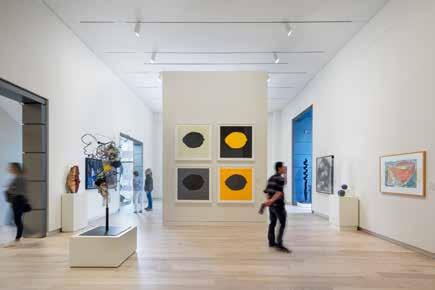






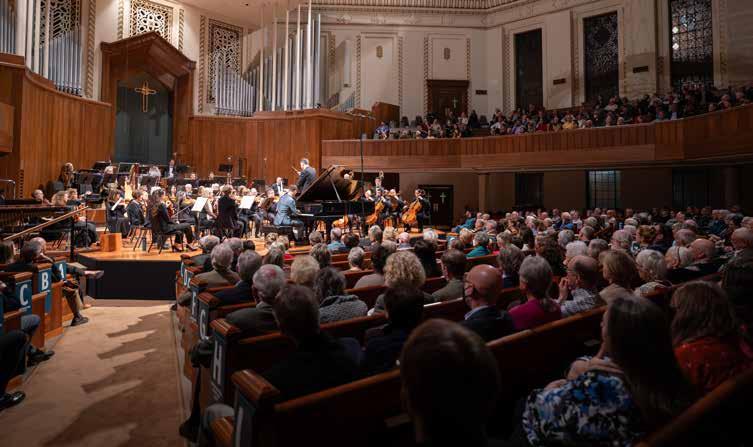
All seven Masterworks concerts will take place at First Baptist Church of Asheville.
The following page includes a floor plan of the ground level indicating entrances in addition to the surrounding streets and parking areas.
Following our successful performances at First Baptist Church of Asheville during the 2023-2024 season, we are pleased to announce it as the home of the Masterworks Series for three more years.
FBCA offers excellent acoustics, an intimate setting, ample parking, accessible seating, and many patron improvements. We are excited to extend our partnership with FBCA and produce more incredible, acoustically stunning performances for our dedicated audience.
We extend our sincere gratitude for your continued support. Your contributions to our Annual Fund sustain our artistic endeavors. Please consider donating to support our mission of promoting symphonic music for the people of Western North Carolina. Your generosity allows us to continue bringing outstanding performances to all.
Visit AshevilleSymphony.org for more details on the 20242025 season, our performances, how you can support your Asheville Symphony, and much more.
MASTERWORKS ENTRANCE
Performance Space SANCTUARY TO HOUSE LEFT TO HOUSE
CHAPEL Location of Symphony Talk
ACCESSIBILITY & SYMPHONY TALK ENTRANCE



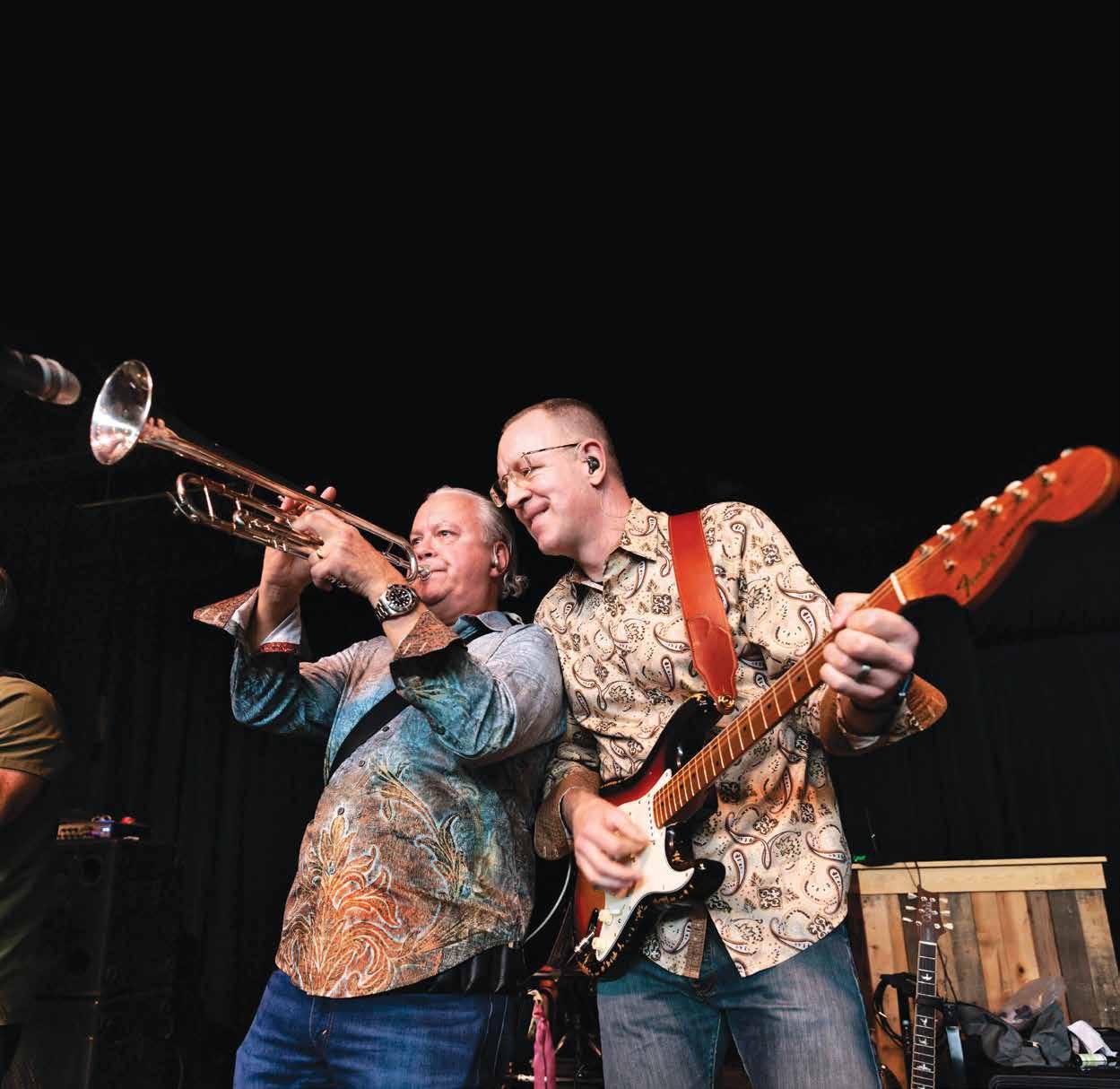
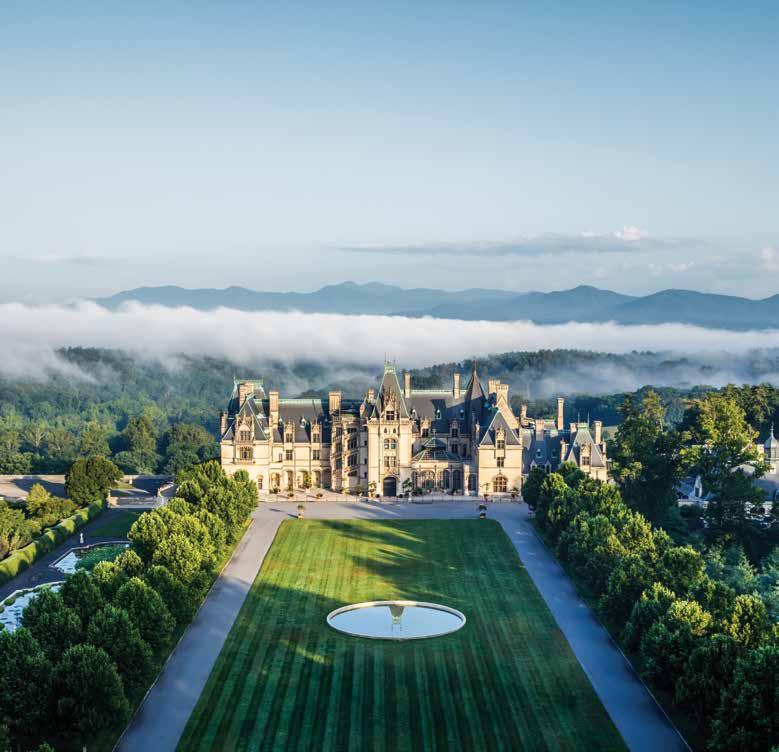



Darko Butorac stands out as one of the most compelling conductors of his generation, praised for his “exceptional combination of passion, elegance, and well-timed pacing” (Westdeutsche Zeitung). He serves as the Music Director of the Asheville Symphony Orchestra, where his innovative programming and dynamic leadership have captivated audiences.
Butorac has guest-conducted numerous prestigious orchestras across Europe, Asia, and the Americas. Notable performances include the Deutsche Kammerphilharmonie Neuss and the Georgische Kammerorchester Ingolstadt (Germany), the Rubinstein Philharmonic of Lodz (Poland), the Xiamen Symphony (China), the Tallinn Sinfonietta (Estonia), the Belgrade Philharmonic, and the Slovenian Radio Symphony Orchestra. His passionate and precise interpretations have earned him widespread acclaim.
He has collaborated world-renowned artists such as Renée Fleming, Garrick Ohlsson, Olga Kern, Lawrence Brownlee, Jon Kimura Parker, Noah BendixBalgley, Anthony McGill, and Oscar-winning actor J.K. Simmons. He has appeared at prestigious venues such as the Vienna Konzerthaus, the Gran Teatro Nacional of Lima, Belgrade’s Kolarac Hall, the Teatro Magnani in Italy, and the Tartu, Aspen, and St. Olav summer music festivals.
In addition to his work in Asheville, Butorac served as the Music Director of the Tallahassee Symphony, where he was known for innovative programming and community engagement. He broadened the orchestra’s reach, introducing eclectic repertoires that attracted new audiences and fostered a deeper appreciation for orchestral music.
A cornerstone of Butorac’s career is his commitment to education and outreach. He has led masterclasses and workshops worldwide, sharing his expertise with the next generation of musicians. During the COVID-19 pandemic, he pioneered virtual formats to keep the orchestral experience alive for audiences and students alike.
As a Grand Prix Laureate of the Vakhtang Jordania International Conducting Competition, Butorac’s accolades reflect his exceptional talent and dedication to the art of conducting. His TEDx talk on leadership and the role of the conductor has garnered nearly 200,000 views, resonating with a wide audience and highlighting his ability to inspire both within and outside the concert hall.
Fluent in multiple languages and deeply rooted in a multicultural background, Butorac brings a unique perspective to his work, blending tradition with innovation. His vision for the future of orchestral music emphasizes inclusivity, accessibility, and artistic integrity, continually striving to break down barriers and bring the transformative power of music to all.
For more about Darko Butorac and his upcoming engagements, visit his official website, www.darkobutorac.com.
Violin
Open Chair • Concertmaster
Martha Gardner • Associate Concertmaster
⁺Karen Pommerich
Assistant Concertmaster
Katheryn Gardner Triplett
Principal Second Violin
Debra L. Anthony
Associate Principal Second Violin
⁺Pedro Oseias Maia
Assistant Principal Second Violin
Marianna Brickle
Teresa M. Curran
Elizabeth Fee-Elliott
Lori G. Hammel
Dorothy L. Knowles
Virginia Kowal
LuAda Malcom
Ruben Orengo
Mariya S. Potapova
Inez Hullinger Redman
*Paul E. Stroebel
Viola
Kara F. Poorbaugh • Principal
Open Chair • Associate Principal
Kathryn Bracewell
Hannah Dara
Martha L. Geissler (loa)
Gina Mashburn Heath
Edward J. Smith
Daphne Waggener
Cello
Daniel Mumm • Principal
J. Franklin Keel • Associate Principal
Paul Maxwell • Assistant Principal
Cherylonda F. Fitzgerald
Paul S. GhostHorse
Katie Hamilton
Patricia Koelling Johnston
E. Sojeong Park
Bass
*M. Lee Metcalfe • Co-Principal
Vance M. Reese • Co-Principal
Michael Di Trolio
Matthew P. Waid
Flute
Lissie J. Shanahan • Principal
Kellie Henry
Piccolo
Dilshad B. Posnock
Oboe
Alicia Chapman • Principal
*Cara Mia Jenkins
English Horn
Amanda J. LaBrecque
Clarinet
Harry H. “Chip” Hill • Principal
Karen Farah Hill
Bass Clarinet
Shannon Thompson
Bassoon
Michael J. Burns • Principal
Amber Ferenz
Contrabassoon
William L. Peebles
Horn
Jeffery B. Whaley • Principal
*Michael L. Brubaker
Anneka A. Zuehlke
Travis A. Bennett
Trumpet
T. Mark Clodfelter • Principal
⁺Christopher Underwood
⁺William Stowman
Trombone

Justin Croushore • Principal
L. Rienette Davis
Bass Trombone
⁺Michael Hosford
⁺Bill Reichenbach
Tuba
Bethany Wiese • Principal

Timpani
Todd D. Mueller • Principal
Percussion
Caleb Breidenbaugh • Principal
Michael Morel
Matthew Richmond
*Brian Tinkel
Harp
Open Chair • Vetust Study Club Chair
Keyboard
Open Chair • Susanne Marcus Collins Chair
Be a part of Asheville Symphony history!
This season, five outstanding finalists will audition for the role of our Concertmaster. Join us throughout the 2024-2025 Masterworks Series to experience all five candidates!
Masterworks 1
Nash Ryder
Masterworks 2
Benjamin Sung
Masterworks 4
Brian Allen
Masterworks 6
Jackie Tso
Masterworks 7
Evgeny Zvonnikov
Michael Di Trolio • Principal Librarian
Paul Stroebel • Stage Manager
* Orchestra Committee Member
⁺ One Year Appointment
Section string players are listed alphabetically.
(loa) = Leave of Absence

Thank you to our incredible musician hosts!
The generosity and warmth of our musician hosts creates a welcoming home-awayfrom-home for our traveling musicians. Thank you for being an integral part of the Asheville Symphony community!
Mary and Jack Anderson
John Boneparth and Gail Harris
Madison Brightwell
Linda and Tom Bushar
Georgia Case
Teresa Curran
Kathy and George Dambach
Suzanne and Steven Hageman
Stan Ingber and Laura Robbins
Mary and Peter Holmes
Mountaine Jonas
Pam and David Lane
Jill and Joe Lawrence
Robin and Cliff Lively
Susan and David Leader
Sue and George Luther
Jim McAllister
Carol and Hugh McCollum
Geoffrey Mitchell and Clair Griffith
Connie and Gary Wald


We applaud the Asheville Symphony Orchestra for sharing one of life’s greatest treasures with our community.
“Where Words Fail, Music Speaks” – Hans Christian Andersen
of the Arts The Brookshire Garside Group Private Wealth Management 828-239-8781 BrookshireGarsideGroup.com



The Asheville Symphony Guild proudly supports the Asheville Symphony and Asheville Symphony community initiatives through volunteer support and fundraising. For over 50 years, the Guild has worked as a volunteer organization providing numerous ways for members to contribute to the community, share a mutual love of music, and make a difference in the lives of children through support of music education programs.

MUSICAL FEASTS: YOUR SOCIAL AGENDA AWAITS!
From garden parties to barbecues to elegant evenings — join the Guild and experience these fun Musical Feasts while supporting our Symphony!

The Guild introduces thousands of elementary school children to classical music each year through the Music in the Schools program. The Guild also helps support our wonderful Asheville Symphony Youth Orchestra.
GUILD GATHERINGS: SHARE THE LOVE!
From our Fall Potluck to the annual May Gathering, Guild members enjoy getting together to share their love of music and our wonderful Symphony.
If you love music and want to form a deeper connection to the Asheville Symphony, your community, and your peers, we invite you to join the Guild today! For more information and to join, visit AshevilleSymphonyGuild.org or scan the QR code.

The Asheville Symphony Chorus (ASC) seeks to enrich and inspire our community through impactful performances of the masterworks of choral music. Under the direction of Kyle Ritter, the ASC invites you to take part in their 33rd season.
SPRING CONCERT: MUSIC FOR KINGS & QUEENS
May 6, 2025
Featured pieces: Coronation Mass by W.A. Mozart and Zadok the Priest by G.F. Handel
CHAMBER CHORUS CONCERT
May 20, 2025
Location and program to be announced.
Check our website for Spring concert updates! You can also find more information about the chorus as well as audition dates online by scanning the QR code on this page or by visiting www.AshevilleSymphonyChorus.com.


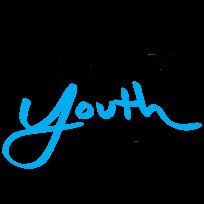
The Asheville Symphonettes is a high school girl’s service club dedicated to supporting the Asheville Symphony since 2011. By involving students in the production of live symphony concerts, the club fosters a lifelong appreciation for classical music, while also cultivating enduring friendships and community improvement. The Symphonettes actively contribute to the Buncombe County music community by greeting Asheville Symphony patrons, distributing program books, and organizing service projects. Last season, the Symphonettes ran an instrument drive to donate lightly used instruments to local school music programs.
For membership and funding inquiries, please contact Lisa Owen at lisacort1@yahoo.com.

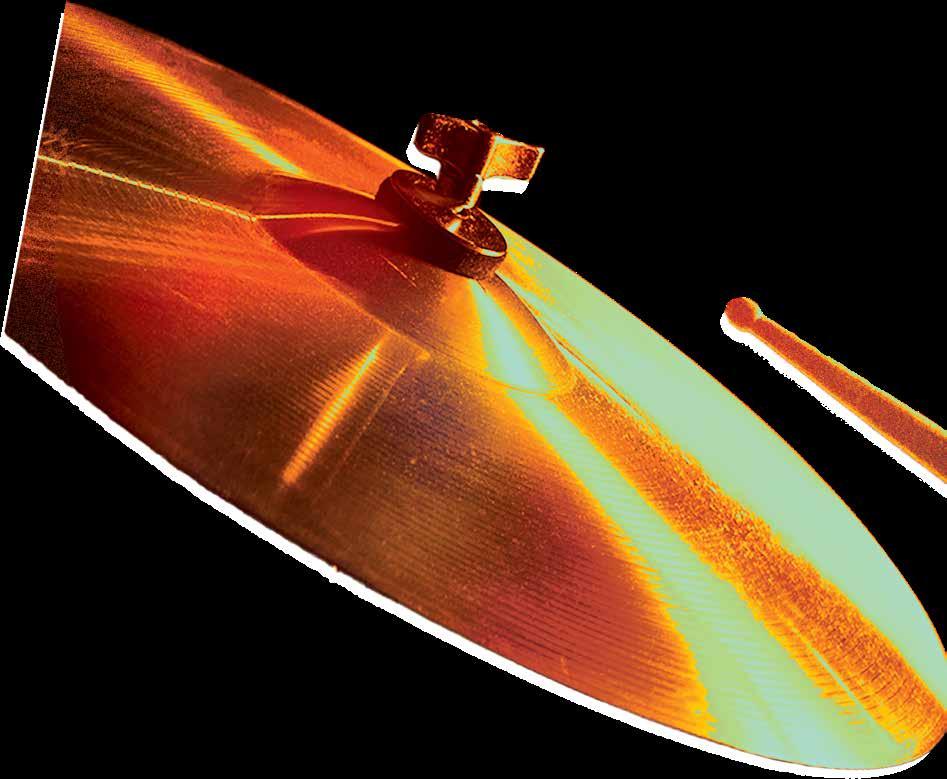

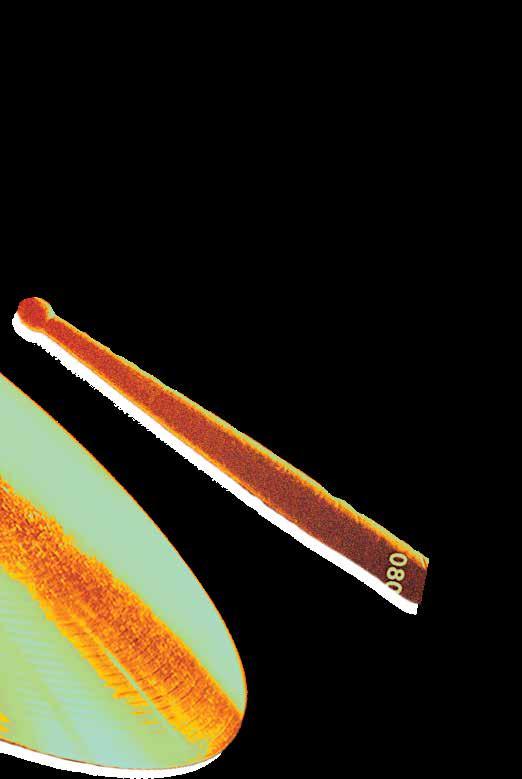

Darko Butorac, Conductor
Keri Fuller, Vocalist
Rock out with ALT ASO at The Orange Peel as we bring you a night of electrifying classic rock hits! Featuring the incredible Keri Fuller, known for her roles as Jane Seymour in the Broadway production of Six the Musical and her performances in Jagged Little Pill and Waitress. Don’t miss your chance to experience this program featuring your favorites from STYX, Fleetwood Mac, Journey, Led Zeppelin, Kate Bush and more.
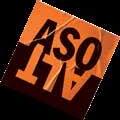
TUESDAY, JANUARY 14, 7:00 P.M.
SERIES PRESENTING SPONSOR

AMBER SPONSORS
Craig Allen & Julie Cowden
Donald Gavin & Jayne Schnaars
David & Dianne Worley



BOHEMIAN SPONSORS


GOLDEN SPONSORS
Michael & Catty Andry


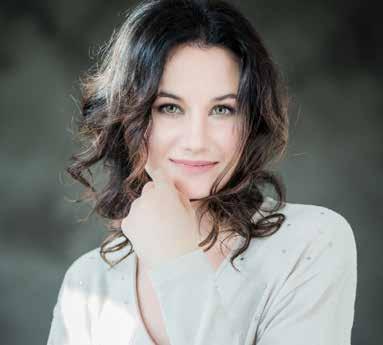
First Baptist Church of Asheville
February 11, 2025
7:00 p.m.
A dynamic recital program by an acclaimed pianist that pairs works from the Baroque period with passionate Romantic compositions, creating a rich journey through two distinctive musical epochs.



During most of his life and up to the present, George Frederick Handel’s fame has rested primarily on his large vocal works, operas, and later, oratorios. As a result, his instrumental music, especially his harpsichord works, suffered neglect. But, considering his harpsichord suites, he was probably one of the finest virtuosos on that instrument.
Handel wrote these suites for his own use and for teaching, possibly for his pupil, Princess Anne. In 1720, at the height of his popularity, pirated editions of his music appeared all over Europe. To counter this, he published eight suites in the first of three volumes of his harpsichord music, with the following comment: “I have been obliged to publish some of the following sessons, because surreptitious and incoherent copies of them had got abroad.” The date of the original composition of these works is unknown.
The six-movement Suite No. 7 opens with a somewhat grand French overture. It is best-known for the last movement, a passacaglia, a set of variations over a base chord sequence that becomes more elaborate and virtuosic as it progresses. Its popularity was enhanced in 1894, when Norwegian violinist, composer and conductor Johan Halvorsen (18641935) arranged and elaborated the Passacaglia for Violin and Viola, going far beyond Handel’s variations.
Johann Sebastian Bach (1685-1750)
It is difficult for us to realize that in his lifetime, Bach’s fame rested mainly on his virtuosity on the clavier (harpsichord) and organ, and less so on his compositions. This reputation was particularly true during Bach’s younger years when he was employed as a church organist and court instrumentalist. At that time, any respectable keyboard player was expected to be accomplished at improvisation, an art in which Bach excelled beyond any of his
contemporaries. The outlet for a musician’s improvisatory skill was the fantasia, a genre whose history dates back to the Middle Ages. The Baroque transformed this form — if it can truly be called a “form” — by making it a vehicle to demonstrate more than mere technical dexterity. In addition to instrumental bravura and virtuosity, freedom of structure and the incorporation of several moods were all expected of the improviser. This is not to say that all fantasias were necessarily improvised; but they certainly were supposed to sound as if they were. The freedom of the fantasy was often contrasted with a fugue, regarded as the strictest of musical genres.
We do not know the circumstances for which Bach composed the Chromatic Fantasy and Fugue. The latest scholarship places its composition during Bach’s employment in the court of Weimar, between 1708 and 1717. Whether Bach performed the work in some improvised form before he committed it to paper is, of course, unknown.
Despite its improvisatory style, the Chromatic Fantasy is a work of highly complex structure. The Fantasy contains two distinct sections — one might even say movements: the first a bravura exploration of sharp dissonances and unexpected modulations; the second an almost operatic recitative that becomes increasingly elaborate. Bach uses the departure into unusual modulations as a means of creating extreme tension, consistently setting up the listener to expect one key and then suddenly shifting into a distant one. In the slow “recitative” he uses the vocal nature of the melodic line and its strange modulatory twists and turns to create an almost tragic mood.
The Fugue, based on a chromatic subject, is appropriately less wayward in tonal shocks to the system. But the nature of the fugue subject itself continues the emotional intensity created by the Fantasy.
Robert Schumann (1810-1856)
Schumann’s early piano works baffled his contemporaries, who called them eccentric, capricious, even bizarre. The Fantasie, Op. 12, composed between 1836 and 1838, made even its dedicatee, Franz Liszt, so uneasy that he seldom performed it. Clara dropped it from her repertoire after one public performance: “Listen Robert, could you just for once compose something brilliant, easy to understand, and without text inscriptions — a totally coherent piece, not too long, not too short?” she wrote in April 1839. Schumann took the hint; his works from later that year — the Arabeske Op. 18 and Faschingsschwank aus Wien — reflected his capitulation to his beloved.
In the fall of 1838, Schumann had traveled to Vienna with the idea of moving there and finding a new home for his magazine Neue Zeitschrift für Musik. He also wanted to take advantage of Clara’s success there, when earlier that year, she was awarded of the title “Imperial-Royal Chamber Virtuoso.” But the response of the publishers and the Court Censor was negative, probably at the instigation of Clara’s father, who vehemently disapproved of Robert’s courtship of his daughter. (Clara and Robert married in 1840 over her father’s objections.) Schumann nevertheless enjoyed Vienna’s cultural life and the winter festivities around New Year, sketching the first four sections of Faschingschwank in the city.
Of course, there’s the inevitable contrast between this work and Carnaval, Op. 9, where Schumann imbued nearly every movement with philosophical and literary references, not to mention autobiographical little puzzles
(continued on next page)
George Frederick Handel
Suite No. 7 in G minor, HWV 432
I. Ouverture
II. Andante
III. Allegro
IV. Sarabande
V. Gigue
VI. Passacaille

Music Sponsor
Sarah Van Gunten
J. S. Bach
Chromatic Fantasia and Fugue in D minor, BWV 903
Music Sponsor
Debbie Green
INTERMISSION
Robert Schumann
Faschingsschwank aus Wien, Tableaux fantastiques, Op. 26
I. Allegro
II. Romanze
III. Scherzino
IV. Intermezzo
V. Finale
Music Sponsor
Timothy Butts & Susan Harrington Butts
Aleksander Scriabin
Prelude and Nocturne for the Left Hand, Op. 9
Franz Liszt
Réminiscences de Lucia di Lammermoor, S. 397
Music Sponsor
Clair Griffith & Geoffrey Mitchell
CONCERT SPONSOR
and anagrams. As per Clara’s “suggestion,” the five sections of the Faschingschwank are meant to display the pianist’s technical and emotional subtleties.
I. Allegro
The first movement is the longest, a five-episode rondo plus a coda in which each statement of the rondo is slightly different. In general, the episodes provide a gentle contrast with the rondo until the end. The fourth episode contains the “jest” of the title, a short reference to the Marseillaise, which for political reasons at the time was verboten in Vienna.
II. Romanze
A slow, even mournful, movement and the only one in a minor key; it fulfills the role of a second movement of a sonata. It is also the shortest.
III. Scherzino
The mood switches suddenly to “chirpy.”
IV. Intermezzo
Is the passionate analogue to the Romanze and is also quite short.
V. Finale
This bravura showpiece is also a rondo and contains a wealth of thematic material in the episodes.
Aleksander Scriabin (1872-1915)
Short of stature but long on ego, composer and pianist Aleksander Scriabin has been called the bad boy of Russian music. Considered a visionary and musical messiah by some — including himself — to others he was a charlatan and neurotic degenerate. He started formal piano study at the relatively late age of 10, but by 14 he was already composing feverishly. At 16 he entered in the Moscow Conservatory to study piano, where
one of his classmates was Sergey Rachmaninov.
Although Scriabin’s teacher, Nikolay Zverev, discouraged him from composing, he continued to pursue composition with characteristic defiance. His early models were Chopin and Liszt, but he soon avoided any musical influences in order to develop his own musical language; the innovative harmonies that characterize his later music present an instantly identifiable musical fingerprint. The Prelude and Nocturne for the left hand, composed in 1894, however, still reveal his early influences, the Prelude being more Chopinesque, the Nocturne more Lisztian.
Until the 1920s, compositions for the left hand — such as Brahms’s transcription of Bach’s chaconne from the Violin Partita No. 2 — were rare, and mostly designed as exercises. Why Scriabin placed this pianistic restriction on the Prelude and Nocturne is unknown, although they may have been inspired by a temporary right shoulder injury from a carriage accident.
Franz Liszt (1811-1886)
In the nineteenth century, wellto-do families spent hours around the piano, playing and singing. Much of the repertoire was piano arrangements of everything from art songs to full symphonies and operas. At a time when travel was difficult and opportunities to hear live orchestral and operatic performances rare, piano transcriptions were the primary means of disseminating and accommodating the ears of the public to new repertoire and novel musical ideas.
Franz Liszt, the most flamboyant and virtuosic pianist of the century, enriched the piano literature with a steady flow of fantasies, transcriptions, paraphrases, reminiscence, etc. of the music of his forebears and contemporaries. His treatment of the music of other
composers can be broadly divided into two categories: works in which he expressed his own musical response to borrowed themes while showing off his pianistic and compositional prowess; and transcriptions in which he stayed close to the original score, using the piano to imitate the orchestral or vocal sonorities. In transcriptions of vocal music, he considered the text of such importance that he insisted it be printed above the piano part. In his “Réminiscences” Liszt often compressed an entire act into a short concert piece, combining and elaborating the themes, to make them sound as if composed originally for the piano rather than the human voice.
Gaetano Donizetti’s Lucia di Lammermoor premiered in Naples in 1835. It was an ideal topic for Liszt’s romantic nature, and he sat down to compose Réminiscences de Lucia di Lammermoor in 1835-36, basing it on the sextet at the opera’s finale. His original composition was too long for his publisher, who divided it into two issues, publishing the second, based on the scene at the tomb, as Marche et Cavatine de Lucia di Lammermoor de Donizetti.

Program notes by: Joseph & Elizabeth Kahn www.wordprosmusic.com

One of the most exciting artists to emerge in recent years, Martina Filjak is garnering international praise for her poetic passion and technical mastery at the keyboard as well as for her charismatic personality and magnetic stage presence. The New York Times praised her “brilliant, sensitive and imaginative playing with resourcefulness of technique and naturalness of musicality ... a striking individuality ... a pianist to watch.’’
Martina Filjak came to international attention by winning the Gold Medal, the 1st prize and the Beethoven prize at the Cleveland International Piano Competition in 2009, which brought her numerous engagements in the United States and internationally. Prior to that, she won 1st prizes at the Maria Canals Piano Competition (Barcelona) and the Viotti Piano Competition (Vercelli), and was a laureate at the Busoni Piano Competition.
During the past seasons Ms Filjak has performed with esteemed orchestras that include The Cleveland Orchestra, San Diego Symphony Orchestra, The Florida Orchestra, the Strasbourg Philharmonic, Barcelona Symphony, Bilbao Symphony and the Granada Symphony, Turku Philharmonic Orchestra; the Deutsche Radio Philharmonie, the Staatskapelle Halle, the Staatskapelle Weimar; and many more. She has performed at international venues such as the Concertgebouw Amsterdam, Konzerthaus Berlin, l’Auditori and Palau de la Música Catalana in Barcelona, and more.
The artist’s extensive repertoire ranges from Bach to Berio and encompasses more than 30 piano concertos. She is dedicated to continuous exploring of piano literature and various concert formats.



Graphic design studio crafting notice-worthy brands, websites + more for creatives + creators. Proud to collaborate with your Asheville Symphony.


MASTERWORKS 4
First Baptist Church of Asheville February 15, 2025
2:00 p.m. + 8:00 p.m.
Darko Butorac


Only a few days into his visit to Italy, Mendelssohn, like many of us fortunate enough to visit Bel Paese, was already smitten: “This is Italy!” he wrote, “... and I am loving it.” He completed his Fourth Symphony shortly after his return home, and the piece — alongside the other Italyinspired works on the program by Berlioz, Saint-Saëns, and Charpentier — paints a vibrant picture of the country as seen through the eyes of fellow non-Italians, all united in affection for the vivacious Italian culture, food, wine, and spirit.
Hector Berlioz (1803-1869)
Hector Berlioz was a gifted and innovative orchestrator. He freed the brass from its role as mere accompaniment, making it the equal of the other orchestral sections. He experimented with new instruments, such as the bass clarinet and the valve trumpet. And he virtually put the English horn on the map as the solo instrument par excellence for conveying musical melancholy. He was equally innovative in musical form and in stretching the limits of classical tonal harmony.
But one of Berlioz’s great fiascoes was his opera Benvenuto Cellini. A brilliant musical score could not hide an impossible libretto with fatal dramatic flaws. The premiere at the Paris Opera in 1838 survived for just three performances, and an attempt at a revival a few years later failed as well. Only its lively overture, using themes from the opera, has survived in the repertoire.
Never one to waste good music, six years later Berlioz took two of the most fetching musical segments of Act I of the opera and fashioned from them the Roman Carnival Overture, originally meant as the introduction to the opera’s second act. The overture is an orchestral showpiece, beloved by orchestra players, especially the brass. Berlioz took the gentle love duet between Benvenuto Cellini and Teresa, here played by the English horn, and pitted it against the irresistible choral carnival scene with its saltarello dance rhythm. The dance becomes wilder and wilder as the Overture progresses. Only in the last few bars, with their brilliant and unpredictable brass, did Berlioz digress significantly from the opera theme.
In contrast to the opera, the premiere of the overture, under the composer’s baton, was an instant success and had to be encored.
Camille Saint-Saëns (1835-1921)
It is said that at his first public concert in May 1846, after playing Mozart and Beethoven piano concertos as well as some solo works by Bach and Handel, ten-year-old Camille Saint-Saëns offered to play any one of Beethoven’s 32 piano sonatas as an encore — from memory. A child prodigy who grew to become a phenomenal polymath, Saint-Saëns wrote articles and books on many scientific topics, including astronomy, biology and archaeology in addition to his composing and musicological studies.
In his youth Saint-Saëns was considered an innovator, but by the time he reached maturity he had become a pillar of the establishment, trying to maintain the classical musical tradition, conventional forms and harmony in France. As an accomplished organist and pianist — he premiered his five piano concertos — he sported an elegant, effortless technique. But neither his compositions nor his pianism were ever pinnacles of passion or emotion. Berlioz noted that SaintSaëns “...knows everything but lacks in experience.” Saint-Saëns was supportive of some younger composers, but his visceral dislike of Debussy actually engendered endless headlines in the tabloid press.
Saint-Saëns composed the Second Piano Concerto in 1868 at the request of the famed Russian pianist, composer and conductor Anton
(continued on next page)
Hector Berlioz
Le carnaval romain, ouverture pour orchestre, Op. 9
Music Sponsor
Irene & Michael Stoll in memory of Ingeborg Meeke Cristian Rubiano
Dick & Yolanda Hall in memory of our son Rikki
Camille Saint-Saëns
Piano Concerto No. 2 in G minor, Op. 22
Martina Filjak, Piano
I. Andante sostenuto
II. Allegro scherzando
III. Presto

Music Sponsor
Dr. Alan & Suzanne Escovitz
Ann & Jerry McLellan Debbie Green
INTERMISSION
Gustave Charpentier Impressions d’Italie
IV. Sur les Cîmes
Music Sponsor Altura Architects
Felix Mendelssohn Symphony No. 4 in A major, “Italian,” Op. 90
I. Allegro vivace
II. Andante con moto
III. Con moto moderato
IV. Saltarello: Presto
Music Sponsor Hank Young
GUEST ARTIST SPONSOR
Media partner Blue Ridge Public Radio will air a recording of this performance, featuring conversations with the Asheville Symphony, on BPR Classic and bpr.org on Tuesday, March 11 at 7:00 p.m. and Thursday, March 13 at 9:00 a.m.

Rubinstein, who wanted to use it to advance his conducting career. The composer gave the first performance with Rubinstein conducting, to general acclaim. A showy piece, recalling Liszt at his most bombastic and Chopin at his most lyrical, the Concerto is particularly popular among pianists with outstanding technique.
The first movement opens with a lengthy Andante sostenuto introduction, a massive and splashy solo fantasia in and of itself. There follows a thunderous introduction by the whole orchestra. The piano introduces the leisurely first theme, which develops as interplay between the soloist and the woodwinds, especially the flute. The second theme belongs to the piano with occasional upper woodwind accompaniment. The movement becomes a display of brilliant pianistic virtuosity, concluding with a reprise of the introductory material of both piano and orchestra.
The second movement, Allegro scherzando, opens with a rhythmic ostinato on the timpani that provides the pulse for the entire movement. The piano theme sparkles whimsically and is paired with a catchy melody in the orchestra. The movement concludes with a whisper.
The Presto, alla breve finale is a tarantella, too fast for human feet by far. It is a pure bravura piece, full of crashing chords and glittering runs, which received — not unexpectedly — the warmest praise from Franz Liszt.
Gustave Charpentier (1860-1956)
Gustave Charpentier is one of those composers who produced a blockbuster opera and then spent the rest of their life trying unsuccessfully to duplicate this success. Louise, first performed in 1900 at the Opéra Comique, was a tremendous success and achieved its 1000th performance there a few months after the composer’s death in 1956.
The son of a baker and amateur musician who taught him the rudiments of music, Charpentier started working in a spinning mill at fifteen, studying the violin in the evenings. At eighteen he became the mill’s bookkeeper. The mill’s owner, overhearing Gustave’s music making, helped send him to study at the Paris Conservatoire. After the obligatory three years in Rome as winner of the prestigious Prix de Rome in 1887, he settled into the bohemian life of Montmartre where he stayed for the rest of his long life.
Impressions d’Italie, is a five-movement symphonic suite Charpentier composed after his return from Italy in 1889. In Sur les Cîmes he tries to describe the broad vistas with broad, long musical lines.
Felix Mendelssohn (1809-1847)
Felix Mendelssohn is one of a handful of composers whose families recognized and nurtured their gifts. He had inherited the intellect of his grandfather, the eminent Jewish philosopher, Moses Mendelssohn, while his banker father provided all the material comforts befitting a young aristocrat. The Mendelssohn household was a Mecca for the intellectual elite of Germany, and the many family visitors fawned over the prodigy and his talented sister Fanny. Fortunately for the development of his rare abilities, his carefully selected teachers were demanding and strict.
The Mendelssohns joined the many well-to-do families to do the Grand Tour in what was then considered the “civilized” world — Western Europe, Britain and Italy. Some of Felix’s most successful orchestral compositions represent musical travelogues recalling such trips: the “Scottish” and “Italian” symphonies and The Hebrides Overture. An added perk to all this travel was that the family’s connections, and Felix’s reputation as a Mozartian Wunderkind attracted attention to his music throughout Europe. Queen Victoria herself had several audiences with the young composer, during which he played and she sang.
Traveling to Italy in 1830, Mendelssohn stopped in Weimar, where he spent two weeks conversing with the forbidding grand old man of German literature, the 80-year-old Johann Wolfgang von Goethe. It was a heady experience for the young composer, and he continued on to Italy in high spirits. He was at once completely captivated by the sights and sounds of the sunny country and wrote home “...what I have been looking forward to all my life as the greatest happiness has now begun, and I am basking in it.” He immediately set about composing the “Italian” Symphony on commission from the London Philharmonic Society, conducting the premiere in 1833.
The first movement, Allegro vivace, opens with a buoyant theme reflecting the sparkle of the Italian sunshine and the young composer’s rush of excitement. The contrasting second theme is a lilting figure for two clarinets playing in parallel thirds.
The Andante con moto second movement is in a darker mood. It was composed after a visit to Naples, where Mendelssohn was greatly depressed by the poverty he saw. The doleful woodwinds and plodding ostinato in the cellos and double basses may allude to a religious procession he witnessed in the city’s streets.
The charming and graceful Con moto moderato third movement lightens the mood again and uses the traditional scherzo and trio form. The finale, Saltarello: Presto with its driving triplets is based on the nineteenthcentury folk version of a medieval Italian dance. In fact, Mendelssohn may have taken the two dance themes from folk music he had heard at a Roman carnival, which he described in detail in his letters. But this is one of those assumptions that is more guesswork than demonstrable fact. Both themes provide a difficult staccato workout for the upper winds reminiscent of the scherzo from the incidental music to A Midsummer Night’s Dream.
Program notes by: Joseph & Elizabeth Kahn www.wordprosmusic.com
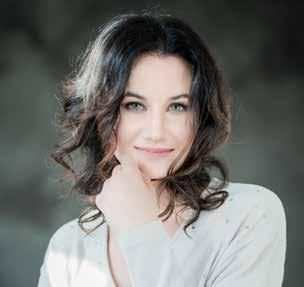
One of the most exciting artists to emerge in recent years, Martina Filjak is garnering international praise for her poetic passion and technical mastery at the keyboard as well as for her charismatic personality and magnetic stage presence. The New York Times praised her “brilliant, sensitive and imaginative playing with resourcefulness of technique and naturalness of musicality ... a striking individuality ... a pianist to watch.’’
Martina Filjak came to international attention by winning the Gold Medal, the 1st prize and the Beethoven prize at the Cleveland International Piano Competition in 2009, which brought her numerous engagements in the United States and internationally. Prior to that, she won 1st prizes at the Maria Canals Piano Competition (Barcelona) and the Viotti Piano Competition (Vercelli), and was a laureate at the Busoni Piano Competition.
During the past seasons Ms Filjak has performed with esteemed orchestras that include The Cleveland Orchestra, San Diego Symphony Orchestra, The Florida Orchestra, the Strasbourg Philharmonic, Barcelona Symphony, Bilbao Symphony and the Granada Symphony, Turku Philharmonic Orchestra, and many more. She has performed at international venues such as the Concertgebouw Amsterdam, Konzerthaus Berlin, l’Auditori and Palau de la Música Catalana in Barcelona, and more.
The artist’s extensive repertoire ranges from Bach to Berio and encompasses more than 30 piano concertos. She is dedicated to continuous exploring of piano literature and various concert formats.

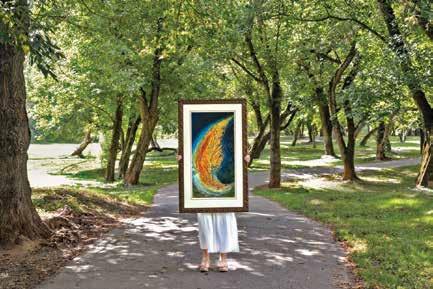
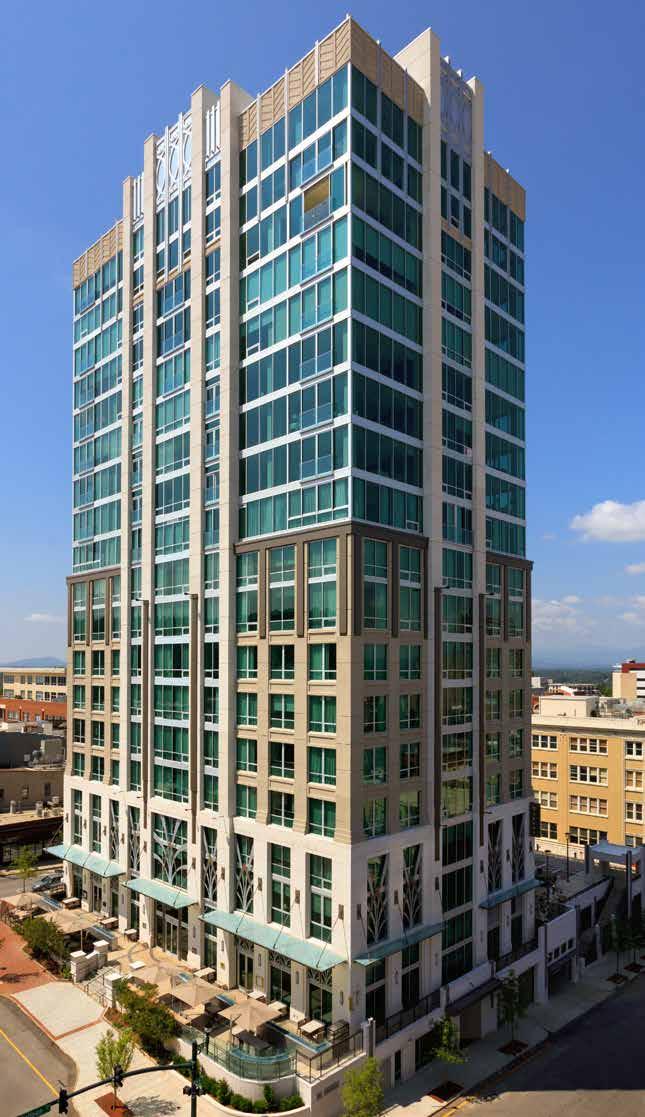







PREMIUM SEASON SPONSORS


MASTERWORKS 5
First Baptist Church of Asheville
March 15, 2025
2:00 p.m. + 8:00 p.m.
Darko Butorac Conductor
Lissie Shanahan Flute
Rebekah Hou Harp
Many 20th-century composers were approached to reinvent Bizet’s Carmen as a ballet, but only Shchedrin accepted the challenge; instead of struggling to outshine the legendary opera, he embraced Bizet’s work and reformed it into a modern, percussioncentric ballet suite. Written for strings, vibraphone, castanets, tamtams, and more, the suite brings the beloved melodies of Carmen to life in unexpected ways. Paired with the Carmen Suite is Montgomery’s Strum!, inspired by American folk idioms and the spirit of dance. Rounding out the program is Mozart’s Parisian concerto for the unique and delightful pairing of flute and harp.
Strum!
Jessie Montgomery (b. 1981)
Jessie Montgomery is a violinist, composer and educator with a graduate degree in Composition and Multimedia from New York University. She is a member of the Catalyst Quartet, and toured with cellist Yo-Yo Ma’s Silk Road Ensemble. She performs and composes regularly for the Sphinx Organization, the Detroit-based social justice ensemble dedicated to transforming lives through the power of diversity in the arts.
Montgomery composed Strum! in 2006 for string quartet and revised it in 2012 for string orchestra for the Sphinx Organization. The work was featured on The Black Composer Speaks concert series by Fulcrum Point New Music Project, which explores different voices within the generations of Black American composers, ranging from impressionistic to pop-inspired minimalism to free jazz improv.
Complex pizzicato lines on all instruments, sometimes as complex as in a Bartok quartet, other times recalling banjo strumming, provide a rhythmic base upon which Montgomery hangs bursts of fiddle music.
A review of her debut album, Strum, Music for Strings, exemplifies Montgomery’s dedication to Sphinx’s founding principles. “The album combines classical chamber music with elements of folk music, spirituals, improvisation, poetry and politics, crafting a unique and insightful new-music perspective on the cross-cultural intersections of American history.”
Wolfgang Amadeus Mozart (1756-1791)
In March 1778 Mozart arrived in Paris with his mother in the hope of obtaining lucrative commissions or even a position in the city’s musical community. The six-month stay turned into a disaster. Paris was in the grip of a fierce musical-political battle between the French operatic style of Christoph Willibald Gluck and the Italian style of Niccoló Piccini. As a result, few people of influence showed interest in helping Mozart secure an appointment, or even the opportunity to appear as a performer except in his own works. Teaching opportunities were few, and the only commissions were for the ballet Les petits riens, the Symphony No.31 in D (“Paris”), a lost Sinfonia Concertante (parts of which probably resurfaced in the Sinfonia Concertante K.anh.9/297b, considered spurious) and the Concerto for Flute, Harp & Orchestra. Money was scarce and father Leopold had to send help from Salzburg. To cap it all, Mozart’s mother died during the visit.
Obtaining commissions and fulfilling them is one thing; getting paid for them is another. The commission for the Concerto for Flute and Harp came from Comte Adrien-Louis de Guines, an amateur flutist, and his daughter, an excellent harpist. The work was premiered by the father/daughter team in April 1778, but in August Mozart complained that he had not yet been paid. Nor had he been paid in full for composition lessons he had given the daughter. Whether he ever got his just remuneration, we do not know.
Jessie Montgomery Strum!
Music Sponsors
Adarrell Gadsden & Marcie Ownbey
Debbie Green
Kay Dambach

(continued on next page)
W. A. Mozart
Concerto for Flute, Harp, and Orchestra in C major, K. 299/297c
Lissie Shanahan, Flute Rebekah Hou, Harp
I. Allegro
II. Andantino
III. Rondo: Allegro
Music Sponsors
Sarah Van Gunten
B.A. & Gary Schenk
Beverly Briedis in memory of Chuck Briedis
Rodion Shchedrin
Carmen Suite, Op. 37
I. Introduction
II. Dance
III. First Intermezzo
IV. Changing of the Guard
V. Carmen’s Entrance and Habanera
VI. Scene
VII. Second Intermezzo
VIII. Bolero
IX. Torero
X. Torero and Carmen
XI. Adagio
XII. Fortune-Telling
XIII. Finale
Music Sponsors
Jim & Mary Kirby
George & Kathy Dambach
Hank Young
GUEST ARTIST SPONSORS
Media partner Blue Ridge Public Radio will air a recording of this performance, featuring conversations with ASO, on BPR Classic and bpr.org on Tuesday, April 8 at 7:00 p.m. and Thursday, April 10 at 9:00 a.m.
The soloist combination in the Concerto is unusual. The harp of the time was a delicate instrument while the penetrating sound of the flute readily drowns out the much mellower harp. Mozart admirably solved the difficulty created by the large difference in the dynamic ranges of the two instruments by keeping the overall tone of the concerto softspoken.
In an unusual approach for concertos of Mozart’s time, both soloists enter with the entire orchestra in a fanfare motif for the first two measures, after which the themes are introduced by the orchestra alone. The flute and harp then enter together and elaborate on the themes, either echoing each other or playing duets with minimal orchestral accompaniment.
In the dreamily romantic second movement, Andantino, the strings alone accompany the solo instruments, which serenade each

other gracefully. To create a contrast in mood, the horns and oboes return in the rondo-allegro last movement for a lively gavotte rhythm. In the solo passages, the flute and harp alternate as principal and accompanying soloist.
Since the Comte and his daughter were amateurs, they could not be expected to improvise their own cadenzas, as was expected of professional soloists at the time. Although Mozart wrote out the cadenzas in full, they have been lost, allowing today’s presumably more proficient performers to choose from a variety of later cadenzas or compose their own.
According to his letters and comments, Mozart disliked the flute and hated to write for it. But although often infantile in his private behavior, he was a pro through and through as a musician. His personal feelings did not deter him from composing wonderful music for the instrument.
Rodion Shchedrin (b. 1932)
One of the most prolific of Russian composers of the second half of the twentieth century, Rodion Shchedrin was born in Moscow, the son of a composer and a professional violinist who taught at the Moscow Conservatory. He graduated from the Conservatory where he subsequently taught composition. Since 1969 Shchedrin has worked as a freelance composer. In 1973 he succeeded Dmitry Shostakovich as chairman of the Composers’ Union of the Russian Federation and in 1990 was made honorary chairman of the organization. Since 1992 he has divided his time between Moscow and Munich, composing and teaching. Shchedrin’s style is eclectic; he has a knack for combining the most avant-garde styles and methods with traditional folk and Russian church music. He has composed in all
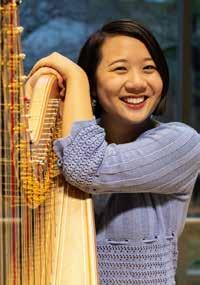
Rebekah Hou is currently pursuing a master’s degree in harp performance at the Cleveland Institute of Music as a student of Yolanda Kondonassis, having graduated with honors from CIM with her bachelor’s degree in 2023. A graduate of Interlochen Arts Academy, Rebekah studied under Joan Raeburn Holland as a recipient of the Orchestral Fellowship and the Fine Arts Award for Harp. Most recently, Rebekah was a prizewinner of 2023 CIM Concerto Competition and performed Alberto Ginastera’s harp concerto with the CIM orchestra. She also received the Anne Adams Award from the American Harp Society’s National Foundation competitions in 2022.
As an orchestral musician, Rebekah has appeared as guest principal harpist of several orchestras in the Northeast Ohio area including Akron Symphony, Firelands Symphony, and Mansfield Symphony. She has also received fellowships from Round Top Orchestral Institute, Chautauqua Festival, Interlochen Arts Camp’s World Youth Symphony Orchestra, and Carnegie Hall’s National Youth Orchestra of the United States (NYO-USA). Her performances with each festival have included collaborations with acclaimed conductors including Larry Rachleff, JoAnn Falletta, Brett Mitchell, and Carl Topilow. Most notable orchestral performances were from the NYO-USA 2019 American and European tour, which was directed by Sir Antonio Pappano and joined by guest artists Joyce DiDonato and Isabelle Leonard. Highlights of the tour included Carnegie Hall in New York, the Konzerthaus in Berlin, Usher Hall in Edinburgh, Royal Albert Hall for the BBC Proms, the Royal Concertgebouw in Amsterdam, and the Elbphilharmonie in Hamburg.
musical genres, including three operas and five ballets, twelve concertos, two symphonies and many other orchestral, chamber and vocal works. His larger compositions are marked by non-traditional structures; the Third Piano Concerto is a set of variations on a theme that is heard only at the end. Much of his music, especially since the mid-1980s, is neo-Romantic and always laced with musical irony and humor.
In addition to his many original works, Shchedrin has enjoyed “recomposing” other composers’ music. In fact, the ballet Carmen, a recomposing of George Bizet’s opera, first brought him to the attention of the West. Shchedrin composed the ballet in 1967 for his wife, Maya Plisetskaya, then prima ballerina of the Bolshoi. He extracted from the ballet a suite of 13 movements, scored for strings and an army of percussion instruments requiring five percussionists. With sly humor Shchedrin took Bizet’s familiar melodies, serving them up in ways Bizet would never have dreamed of. Listeners should not seek a correspondence with the opera, except in the themes; Shchedrin changes the order of the melodies and does not attempt to follow the plot.
In love with Bizet’s music, he also could not resist adding to the stew the farandole from the incidental music to the play L’Arlésienne and the Danse bohèmienne from the opera La Jolie Fille de Perth. The Suite nearly foundered on the shoals of Soviet bureaucracy, who considered it “insulting to Bizet’s masterpiece.” Only intervention by Shostakovich rescued it and had it reinstated on the officially approved list.

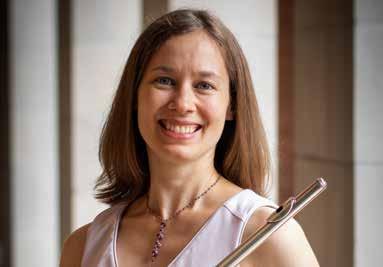
Lissie Shanahan is the Principal Flutist of the Asheville Symphony, a position which she has held since 2009. She also serves as the Piccoloist of the Winston-Salem Symphony. Ms. Shanahan has previously served as Principal Flute with the Asheville Lyric Opera and Second Flute with the Western Piedmont Symphony. She has performed as guest Principal Flute with the New World Symphony, Winston-Salem Symphony, Salisbury Symphony, and more. She also performed in the National Repertory Orchestra and the Sarasota Music Festival. She has presented recitals at High Point University, Davidson College, Lenoir-Rhyne University, and St. Mary’s Music Academy in High Point and was a founding member of the Elektra Winds, an all-female woodwind quartet based in Winston-Salem. This performance serves as her return as a soloist with the Asheville Symphony, having previously performed the Orchestral Suite No. 2 by J.S. Bach in 2013. Additional concerto performances have been with the BirminghamBloomfield Symphony, the Blue Lake Festival Orchestra, and the High Point University Orchestra. Other honors include First Prize in the 2003 Detroit Bohemian Concerto Competition and Third Prize in the 2011 Myrna Brown Artist Competition.
Michigan native Shanahan lives in Winston-Salem with her husband Peter, also a flutist. Together, they lead the Winston-Salem Flute Academy and Youth Flute Ensemble. She serves as Instructor of Flute and Ensemble Director at High Point University, where she also performs as Principal Flutist in the HPU Orchestra. Her teaching experience includes positions at Lenoir-Rhyne University, Long Island Conservatory, Juilliard Pre-College, and more. She conducts masterclasses at local schools, and, as part of the Winston-Salem Symphony Woodwind Quintet, she performs educational concerts throughout Forsyth County.
Program notes by: Joseph & Elizabeth Kahn www.wordprosmusic.com
Ms. Shanahan received her Master of Music from The Juilliard School as a student of world-renowned flute soloist Carol Wincenc. She also holds a Bachelor of Music from the Indiana University Jacobs School of Music where she studied with eminent orchestral flutist Thomas Robertello.
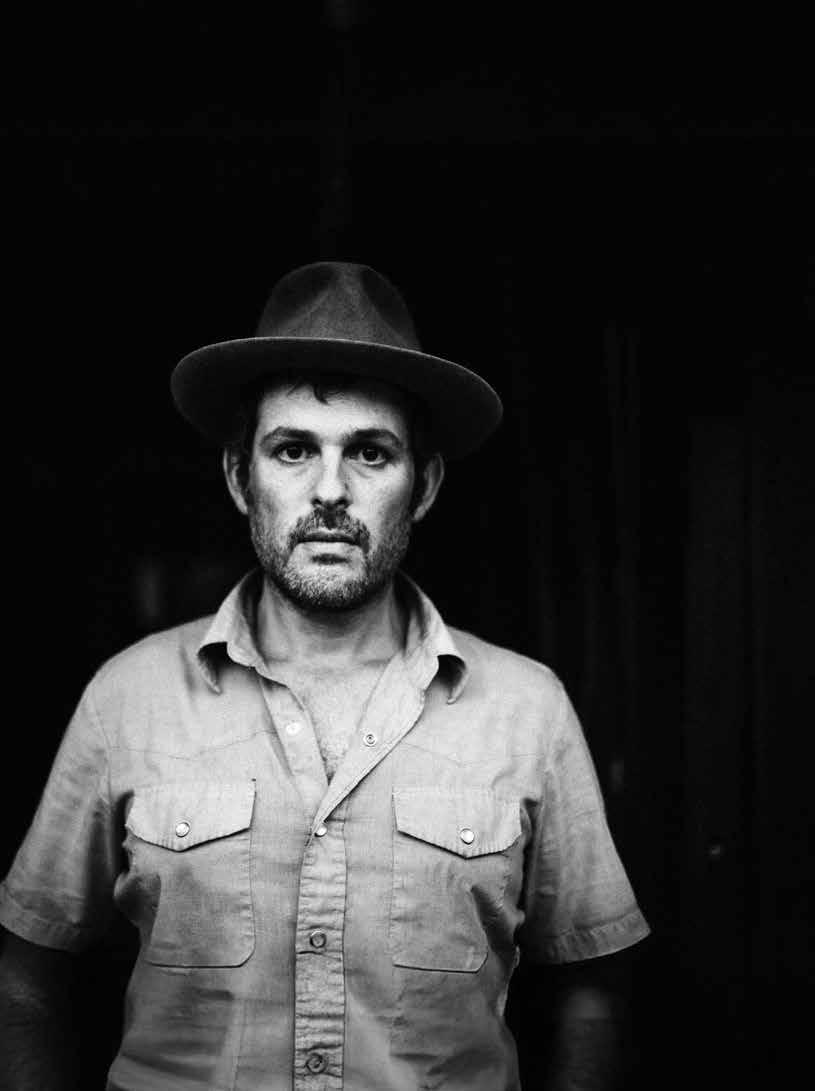



Thomas Wolfe Auditorium
March 18, 2025 at 8:00 p.m.
Gregory Alan Isakov
Christopher Dragon Guest Conductor
Grammy-nominated singer, songwriter and musician Gregory Alan Isakov performs a special headline show featuring the Asheville Symphony Orchestra. The show will include symphonic arrangements of favorites from Isakov’s six full-length albums, including his most recent, the acclaimed Appaloosa Bones, Evening Machines, and Gregory Alan Isakov with the Colorado Symphony. The orchestral versions of these songs were arranged by Tom Hagerman (DeVotchKa) and Jay Clifford (Jump Little Children). The performance will be conducted by renowned conductor Christopher Dragon.
$1 from the sale of each ticket purchased will be donated to Equal Plates Project, who source from local farmers, address food insecurity and build community through the sharing of scratch-made meals in Western North Carolina. Learn more at equalplatesproject.org.

Born in Johannesburg, South Africa, and now calling Colorado home, horticulturist/musician Gregory Alan Isakov has cast an impressive presence on the indierock and folk worlds with his six full-length studio albums: That Sea, The Gambler; This Empty Northern Hemisphere; The Weatherman; Gregory Alan Isakov with the Colorado Symphony; Evening Machines, and Appaloosa Bones. Isakov tours internationally with his band, and has performed with national symphony orchestras across the United States.
Of his most recent record, Appaloosa Bones, the Associated Press praised, “His new songs are relentlessly majestic, a kind of musical morphine,” while Paste declared, “he’s continuing to make expertly-tooled music…it’s reliably beautiful and starkly self-possessed throughout.”
When he isn’t on the road, Isakov spends much of his time writing and recording songs in his barnstudio, as well as running Starling Farm (his farm in Boulder County, Colorado), which provides produce to the farm’s CSA members, local restaurants, and a community food bank.
PREMIUM SEASON SPONSORS



Australian conductor Christopher Dragon is the Music Director of the Greensboro and Wyoming Symphony Orchestras and Resident Conductor of the Colorado Symphony. Dragon has a versatile portfolio ranging from live-to-picture performances including Nightmare Before Christmas in Concert, Toy Story in Concert, and Star Wars in Concert, a wide variety of collaborations with artists such as Gregory Alan Isakov, Wu-Tang Clan, Nathaniel Rateliff, Violent Femmes, Lettuce, Cynthia Erivo, Joshua Bell, and Renee Fleming, to standard and contemporary orchestral repertoire; all areas of which he has become highly sought after.

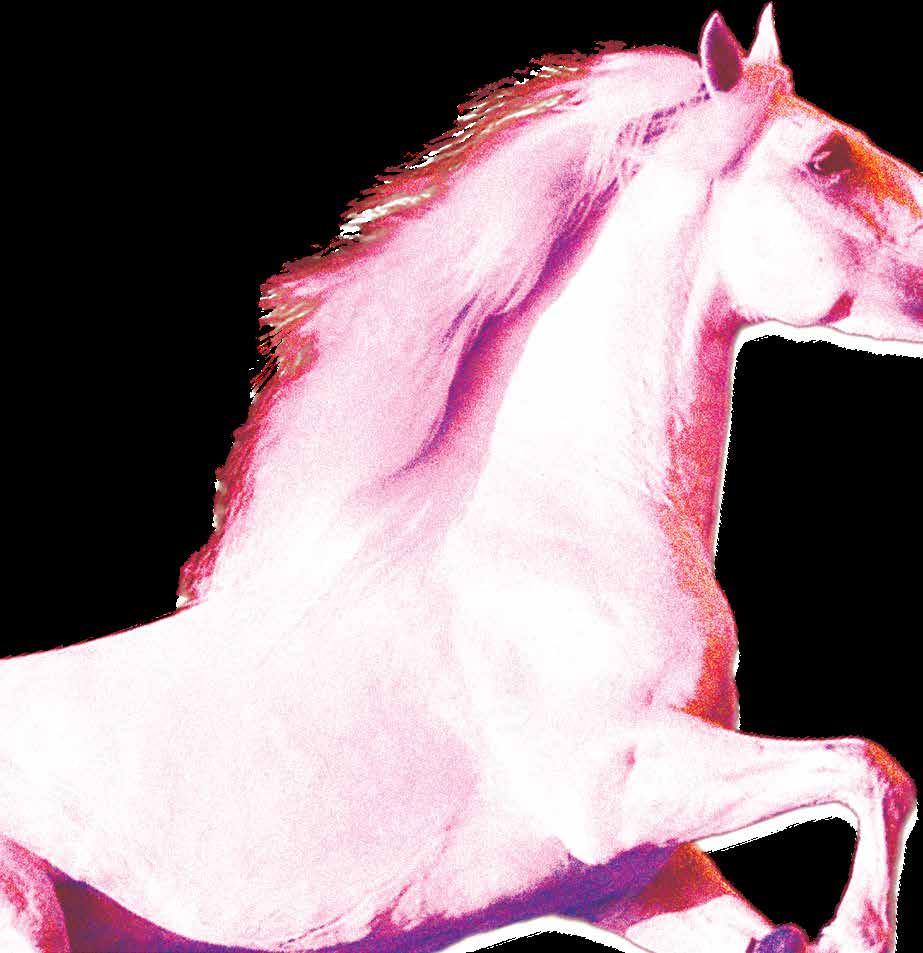




Darko Butorac, Conductor
Erica Gabriel, Vocalist
Wanna dance with somebody? Join us at White Horse Black Mountain for an evening of R&B, pop, and soul with the sensational Erica Gabriel. From classical elegance to the music of Whitney Houston and beyond, this concert promises to be a night of powerful vocals and soulful melodies.
TUESDAY, MARCH 25, 2025
7:00 P.M.
SERIES PRESENTING SPONSOR

AMBER SPONSORS
Craig Allen & Julie Cowden
Donald Gavin & Jayne Schnaars
David & Dianne Worley



BOHEMIAN SPONSORS


GOLDEN SPONSORS
Olivia & Gary Zahler














PREMIUM SEASON SPONSORS


MASTERWORKS 6
First Baptist Church of Asheville April 12, 2025
2:00 p.m. + 8:00 p.m.
Darko Butorac Conductor
Joshua Roman Cello
Artists have always been drawn to the troubling but profound notions of fate, destiny, and inevitability. Verdi’s La forza del destino explores destiny as an irresistible force, bringing lovers together only to tear them apart through tragic twists of fate. The Awakening cello concerto, composed and performed by Joshua Roman, charts a journey from darkness to personal rebirth through the affirmation that no one is alone. Tchaikovsky’s Fifth Symphony completes our exploration of fate with emotional intensity and optimism, weaving a compelling theme through each movement that’s said to be symbolic of the unrelenting call of fate itself.
Giuseppe Verdi (1813-1901)
In 1862, Giuseppe Verdi was at the zenith of his popularity, his name identified with the Risorgimento (unification of Italy) the previous year. The cry “Viva Verdi” not only hailed the composer but was also the acronym for Vittorio Emmanuele Rè D’Italia, the new king. Verdi was elected as a member of Italy’s first parliament.
While his early and middle period operas all premiered in Italy, Verdi began to receive important commissions from beyond the borders, especially from the Paris Opera. Two singers on tour in Russia started the ball rolling for the composer’s first and only Russian commission. Based on a contemporary Spanish play, La fuerza del sino by Angel Pérez de Saavedra, Duke of Rivas, this Italian melodrama — as operas were called in Italy — fit perfectly into the cosmopolitan court of the liberal Tsar Alexander II. La forza del destino premiered in St. Petersburg in 1862. Verdi revised the entire opera, including the overture, for its Italian premiere in 1869.
As for the plot — an inexorable series of misfortunes pursues Don Alvaro and Leonora, whose father he has inadvertently shot while trying to elope with her. The lovers separate and attempt to find exculpation and inner peace, only to be hounded and finally defeated by fate. The Overture is replete with themes from the opera itself, outlining the inexorable course of the lovers’ destiny. The opening motive, three unison Es for the brasses followed by a repeated agitated figure in the low strings, represents fate and recurs each time destiny deals the lovers yet another blow. The motive, whether hovering in the background or blared out by the full orchestra, haunts each theme in Verdi’s brilliant orchestral thematic summary of this long, convoluted opera.
Joshua Roman (b.
1983)
Cellist and composer Joshua Roman, a native of Oklahoma City, began playing the cello at the age of three on a quarter-size instrument, and gave his first public recital at age ten. He pursued his musical studies at the Cleveland Institute of Music, and has made it his commitment to bring Classical music to new and diverse audiences, using digital media to help spread the word.
Roman composed Awakening in 2015, his first cello concerto, and his first major work for cello and orchestra. It was an eye-opener, making Roman aware of the challenge of taking a few initial ideas — whether they come as a sound, a form, a gesture, a transitional mechanism — and turning them into a cohesive musical narrative: “The focus and skill required to compose a work for soloist and orchestra are not easy to come by.”
An unashamedly Neo-Romantic work, Awakening is in five sections, or movements (attacca), and although according to Roman there is no direct narrative, it follows the course of an unhappy love affair through its ups and downs to its ultimate collapse and the following moment of apotheosis.
The two beginning and two ending sections display the cello’s singing sound, with broad, lyrical themes. The abrupt middle section projects
(continued on next page)
Giuseppe Verdi
Overture from La forza del destino
Music Sponsors
Judith Van Horne & Stephen Hendricks in celebration of The Asheville Symphony Youth Orchestra
Robin & Gordon Gaiser
John & Suzie Donahoe
Joshua Roman
Awakening
Joshua Roman, Cello
I. Momentum
II. Possibility
III. It’s You, Not Me
IV. Clinging
V. Awakening, Incorporated
Music Sponsors
Carol & Hugh McCollum
INTERMISSION
Pytor Ilyich Tchaikovsky
Symphony No. 5 in E minor, Op. 64
I. Andante — Allegro con anima
II. Andante cantabile, con alcuna licenza
III. Valse. Allegro moderato
IV. Finale: Andante maestoso — Allegro vivace
CONCERT SPONSOR
GUEST ARTIST SPONSOR

Media partner Blue Ridge Public Radio will air a recording of this performance, featuring conversations with ASO, on BPR Classic and bpr.org on Tuesday, April 29 at 7:00 p.m. and Thursday, May 1 at 9:00 a.m.
the anger of the failing relationship with the percussion dominating, often wiping out the soloist and rest of the orchestra. The final section ends with what could be described as a sigh of relief.
Pytor Ilyich Tchaikovsky (1840-1893)
Throughout his creative career, Pyotr Ilyich Tchaikovsky’s inspiration went through extreme cycles, tied to his frequent bouts of deep depression and self-doubt. In midMay 1888 he wrote to his brother Modest that he was convinced that he had written himself out and that he now felt neither the impulse nor the inclination to compose. By the end of the month, however, he set about “...getting a symphony out of my dulled brain, with difficulty.” Inspiration must have started to flow, for by the end of August, the massive Fifth Symphony was finished.
As was the case with most of Tchaikovsky’s compositions, the premiere of the Symphony — in St. Petersburg, with the composer conducting — earned mixed reactions. The audience liked it, critics panned it and fellowcomposers were envious. Modest believed that the problem with the critics lay with his brother’s lack of confidence as a conductor. Tchaikovsky himself, however, was never at ease with the Symphony, and wrote to his benefactress, Nadeja von Meck: “Having played my symphony twice in St. Petersburg and once in Prague, I have come to the conclusion that it is a failure. There is something repellent in it, some exaggerated color, some insincerity of construction, which the public instinctively recognizes. It was clear to me that the applause and ovations were not for this but
for other works of mine, and that the Symphony itself will never please the public.” For the rest of his life he felt ambivalent about its merits, although after a concert in Germany, where the musicians were enthusiastic, he felt more positive.
The mood of the entire Symphony is set by the introduction, a somber motto in the clarinets that reappears throughout the work and hints at some hidden extra-musical agenda. Perhaps the motto reflects the melancholy and self-doubt Tchaikovsky experienced when he started composing the Symphony; certainly its mood is maintained throughout most of the work, where it casts a pall over whatever it touches. After the introduction, the first movement continues Andante con anima with a resolute march theme, almost a grim procession through adversity. A second beautifully orchestrated theme reveals how many ways there are to represent a sigh in music. Even the idyllic ambiance of the second movement, Andante cantabile, its main theme one of the repertory’s great horn solos, followed by a more animated theme for solo oboe, opens with ponderous introductory measures for the double basses and cellos, playing the underlying harmony of the motto. Later, the movement is interrupted by the sudden recurrence of the motto blasted out by a solo trumpet over the threatening rumble of the timpani.
The third movement is a waltz based on a street melody the composer had heard in Florence ten years before. It also has an undertone of sadness, and towards the end the somber motto is again heard, the mood continuing into the finale.
The last movement presents the motto as the focal point of a final struggle between darkness and
light, symbolized by the vacillation between its original E minor and E major. The stately introduction mirrors the opening of the piece, although in an ambiguous mood and mode. With the Allegro, the key returns decidedly to the minor, but the tempo picks up into a spirited Trepak, a Russian folkdance. Finally, following a grand pause, the key switches definitively to E major — with great pomp and fanfare — for a majestic coda based on the motto and a final trumpet blast of a version in E major of the first movement march.

Program notes by: Joseph & Elizabeth Kahn www.wordprosmusic.com
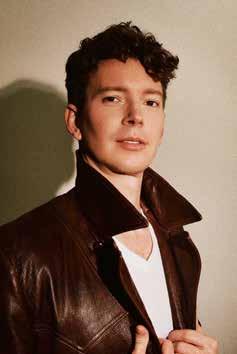
Joshua Roman is a cello soloist and composer, hailed for his “effortlessly expressive tone… and playful zest for exploration” (The New York Times), as well as his “extraordinary technical and musical gifts” and “blend of precision and almost improvisatory freedom… that goes straight to the heart” (The San Francisco Chronicle). His genre-bending programs and wide-ranging collaborations have grown out of an “enthusiasm for musical evolution that is as contagious as his love for the classics” (The Seattle Times).
Committed to bringing classical music to new audiences, Roman opened the acclaimed 2017 TED Conference — and his performance of the complete Bach Cello Suites after the 2016 U.S. presidential election was the mostviewed event in the history of TED’s social channels, with nearly a million live viewers. Roman has collaborated with world-class artists across genres and disciplines, including Yo-Yo Ma, Edgar Meyer, DJ Spooky, Tony-winner/ MacArthur Genius Bill T. Jones, and more.
As a soloist, Roman’s “exceptionally high quality of performances” (The Los Angeles Times) combine “the expressive control of Casals with the creative individuality and virtuoso flair of Hendrix himself” (Gramophone). He has performed with leading orchestras around the United States and the world, including the Los Angeles Philharmonic, San Francisco Symphony, New World Symphony, and more. He was principal cellist of the Seattle Symphony from age 22 to 24.
Roman’s singular 2024-25 season opens with the launch of his ambitious and deeply personal project Immunity, an intimate musical exploration of his life-altering experience of ongoing Long COVID, with music ranging from J.S. Bach to George Crumb to Caroline Shaw, as well as Roman’s own compositions. A recording of the full program will be released October 4 on Bright Shiny Things, coinciding with a tour where Roman will perform music from Immunity in Long COVID clinics across the United States, including New York City, Philadelphia, Seattle, and more. By sharing music and community with other Long COVID patients, Roman aims to raise awareness of the condition and communicate the project’s core message of finding strength in vulnerability.
Additional 2024-25 highlights include a national Trio tour with violinist Tessa Lark and double bassist Edgar Meyer, the world premiere of a new Cello Concerto composed by James Lee III with the Baltimore Symphony Orchestra, two Well-Being concerts with Carnegie Hall, a residency at Stanford University that will center around Immunity, concerto performances with the Pacific Symphony, Louisiana Philharmonic Orchestra, and Asheville Symphony, and solo recitals around the country.
As a composer, Roman has been commissioned by Music Academy of the West, Illinois Philharmonic, ProMusica Chamber Orchestra, San Francisco Girls Chorus, Grace Cathedral, and more, and he has written for the JACK Quartet, violinist Vadim Gluzman, and conductor David Danzmayr. Equally accomplished as an interpreter of the music of other contemporary composers, Roman has premiered works by Mason Bates, Reena Esmail, Timo Andres, Gabriela Lena Frank, Aaron Jay Kernis, Lisa Bielawa, and others. Roman also curated a forward-looking chamber music series at Town Hall in Seattle for 15 years, presenting artists like Jennifer Koh, JACK Quartet, Sō Percussion, and more.
A native of Oklahoma City, Roman began playing the cello at the age of three on a quarter-size instrument, and gave his first public recital at age 10. He went on to pursue his musical studies at the Cleveland Institute of Music, studying with Richard Aaron and Desmond Hoebig, former principal cellist of the Cleveland Orchestra. Roman plays an 1830 Giovanni Francesco Pressenda on a generous loan through The Stradivari Society of Chicago.


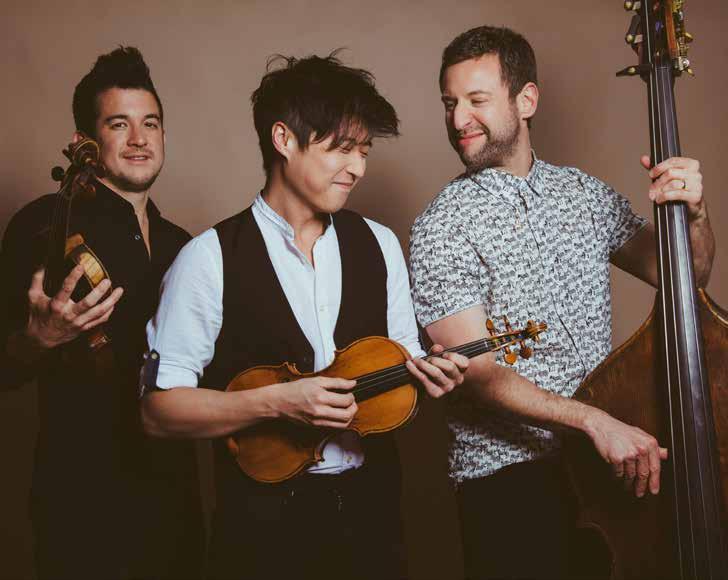
Exclusive Representation of Time for Three Management: Park Avenue Artists
Booking: Opus 3 Artists
May 1, 2025 at 7:00 p.m. The Orange Peel


Nick Kendall, Violin
Charles Yang, Violin
Grammy and Emmy-winning ensemble, Time For Three (TF3), defies convention and boundaries by showcasing excellence across different genres, including classical music, Americana, and singersongwriter. Their unique sound captivates audiences, immersing them in a musical experience that merges various eras, styles, and traditions of Western music. TF3, consisting of Charles Yang (violin, vocals), Nicolas “Nick” Kendall (violin, vocals), and Ranaan Meyer (double bass, vocals), combines their instruments and voices in a remarkable sound, establishing a distinct voice of expression that resonates with listeners worldwide.
TF3’s longstanding history of collaboration with contemporary classical composers continues to thrive. They have worked closely with esteemed artists such as Chris Brubeck and Pulitzer Prize winners William Bolcom and Jennifer Higdon. Their most recent commission, Contact, composed by Pulitzer Prize winner Kevin Puts, premiered with the San Francisco Symphony and The Philadelphia Orchestra in the summer of 2022. This extraordinary piece, alongside Jennifer Higdon’s Concerto 4-3, was released on Deutsche Grammophon under the album title Letters for the Future. Conducted by Xian Zhang, the album’s exceptional quality propelled it onto the Billboard top 10 Classical Recordings charts. Additionally, it garnered a nomination for an Opus Klassik award and received a Grammy win in the Best Classical Instrumental Solo category.
Renowned for their charismatic and energetic performances, TF3 has garnered praise from respected outlets including NPR, NBC, The Wall Street Journal, and the Chicago Sun-Times. They have graced illustrious stages such as Carnegie Hall, The Kennedy Center, and The Royal Albert Hall, effortlessly adapting their inimitable and versatile style to intimate venues like Joe’s Pub in New York or Yoshi’s in San Francisco. TF3 was featured on the acclaimed “Night of the Proms” tour, sharing stages with renowned artists like Chaka Khan and Ronan Keating across several European countries. Their collaborations span a diverse range of artists, including Ben Folds, Branford Marsalis, Joshua Bell, Aoife O’Donovan, Natasha Bedingfield, and Arlo Guthrie.
TF3’s exceptional talents have not only earned them a Grammy win but also secured them an Emmy for their concert special, “Time For Three In Concert,” produced by PBS. Their appetite for new experiences led them to collaborate with cellist and composer Ben Sollee, creating the soundtrack for Focus Features’ film Land, directed by Robin Wright. Premiering at the Sundance Film Festival in January 2021. TF3 has teamed up with Grammy-winning songwriter Liz Rose and Grammy-winning producer Femke Weidema for new recordings released through Warner Music. They have also contributed to Summer Walker’s R&B hit, Constant Bullsxxt, showcasing their versatility across genres.
Time For Three’s artistic achievements, fueled by their relentless pursuit of musical excellence, have solidified their status as a remarkable ensemble. Their Grammy win and extraordinary collaborations speak to their unwavering dedication to pushing creative boundaries and captivating audiences with their exceptional talent.
This Jukebox program, a featured event in this season’s biennial Asheville Amadeus Festival, includes all three members of Time for Three and includes an eclectic mix of original songs, popular covers, and some of the most iconic music ever written. “In person, the members of Time for Three come off as just three dudes in a band,” said NPR. “But with their staggering technique and freewheeling genre-crossing, it’s hard not to be swept up in the force of their contagious energy.” Time for Three will announce all selections from the stage of The Orange Peel.
Billie Marzullo, Rhonda & Marcus Grimes, and Kathy & George Dambach in fond memory of “Lambo” Larry Marzullo

This event is part of the fifth iteration of the Asheville Amadeus Festival, Asheville Amadeus: The Art of Storytelling, featuring co-headliners Chris Thile and Time for Three. The festival brings together some of Asheville’s most talented musicians, artists, creators and entertainers for 11 days of performances, education programs, collaborations and social events. Join us April 30May 10.
For information on the festival, events, and ways to get involved, visit AshevilleAmadeus.org.


PREMIUM SEASON SPONSORS


MASTERWORKS 7
First Baptist Church of Asheville
May 3, 2025
2:00 p.m. + 8:00 p.m.
Darko Butorac Conductor
Time for Three (TF3)
Ranaan Meyer, Double Bass
Nick Kendall, Violin
Charles Yang, Violin
Music possesses an almost magical ability to tell stories. It can paint vivid images of far off lands, enchanted forests, fairy tale villages, the timeless battle between good and evil — all without a single spoken word. Step into the enchanted world of German legends, filled with tales of mysterious swan knights, magic bullets, and mischievous tricksters. Then, delve into the otherworldly Contact; inspired by the idea of interstellar communication, this jazzy, bluegrass-infused, and ethereal concerto for trio was collaboratively written with and for Time For Three.
Carl Maria von Weber (1786-1826)
The premiere of Der Freischütz (usually translated as “The Marksman”) in 1821 marked a turning point in the development of German opera. Until the early nineteenth century, German grand opera had been dominated by Italian composers. The Singspiel, native German-language opera with spoken dialogue instead of recitative, was regarded as more lowbrow. Beethoven elevated the Singspiel to higher level in Fidelio, but in Der Freischütz, Weber created a Singspiel combining all the trappings so dear to the early Romantics: the darkly supernatural, the idealization of the common folk, and, in part, German folksong style that skillfully combined popular music with elements of high art. An overwhelming success, it solidified the entire German school of operatic Romanticism that led directly to the music dramas of Wagner.
Weber based Der Freischütz on a German legend, involving a hunter who sells his soul to the Devil in exchange for a set of charmed silver bullets that hit their mark regardless of where they are aimed. In this struggle between the forces of good and evil, virtue finally prevails — with the help of a good woman. The music is admirable for its charm, folk-like melodies and dance tunes, as well as moments of dramatic tension and excitement. While many of the ideas were to some degree old hat, Weber had managed to combine them in a way that “hit the mark” of the German soul.
Except for the opening horn theme, the overture is made up entirely of melodies from the opera. But rather than stringing the melodies together like a medley, Weber created a finished composition in the form of symphonic sonata form. Its string tremolo, pizzicato basses and pregnant pauses are the quintessence of German Romanticism.
Kevin Puts (b. 1972)
Creating an ensemble with an unusual instrument combination makes for a limited existing repertoire. Time for Three, an ensemble of two violins and a double bass assembled in 2003 at the Curtis Institute, has solved the problem by improvising and arranging their own music — a blend of classical, bluegrass, rock and jazz — and by commissioning new works for their unique combination. In 2020 Kevin Puts composed his triple concerto, Contact, utilizing the unique abilities of the trio — both instrumental and vocal — to create his own vision of space exploration and extraterrestrial contact. He used many of the musical gestures we have learned to associate with space travel through the movie industry, which disregards the reality that in the vacuum of space there is no sound.
The four movements of Contact all contain hints of Puts’s love of bluegrass fiddling:
I. “The Call” opens and closes with an eerie vocal refrain by the trio. It becomes an exchange between the trio and the orchestral winds, especially the woodwinds. Puts suggests that the refrain could be like a message sent into space, a call to intelligent life across the vast distances.
II. “Codes” is a rush of unrelenting energy, challenging the technical mastery of the trio, as well as the orchestra.
(continued on next page)
Carl Maria von Weber
Overture from Der Freischütz, Op. 77
Kevin Puts
Contact
Ranaan Meyer, Double Bass
Nick Kendall, Violin
Charles Yang, Violin
I. The Call II. Codes, Scherzo III. Contact IV. Convivium

Music Sponsor
Michael & Catty Andry
INTERMISSION
Richard Wagner
Prelude to Act I of Lohengrin, WWV 75
Music Sponsor Ashley Sayre Bell
Anne Jarema & Cliff Albertson
Olivia & Gary Zahler
Richard Strauss Till Eulenspiegel lustige Streiche, Op. 28
Music Sponsor Dick Hall in memory of Yolanda Hall
CONCERT SPONSOR
in memory of Katherine Armitage & Jack Jones
GUEST ARTIST SPONSOR


III. “Contact” opens with a grim contrast, cold and stark. Puts writes: “I had the image of an abandoned vessel floating inert in the recesses of space. The soloists interrupt this with a quiet, gently rolling meditation, eventually inviting a solo oboe and a solo clarinet to join in lyrical counterpoint high above. Eventually, the soloists recall the stark opening of the movement, rendering its rhythms into an unaccompanied phrase of tenderness and longing.”
IV. Puts writes about “Convivium”: “I was serendipitously introduced to the wonderful gankino horo (Ganka’s Dance), a traditional Bulgarian melody.... I began playing it on the piano and gradually my own compositional voice crept in. I was reminded of Bartok’s haunting Romanian Folk Dances and the composer’s fusion of his own musical sensibilities with age-old folk melodies. And so I set about composing a sort of fantasy on this tune, its asymmetric rhythmic qualities a fitting counterbalance to the previous three movements.”
But after a pause towards the end of the movement, a new theme emerges, which is a close ringer to a Spanish 16th century melody used by Joaquin Rodrigo in the third movement of his Concierto de Aranjuez. Puts subjects it to a series of free variations, way beyond what the conservative Rodrigo would have ever dreamed of doing.
Kevin Puts teaches composition at the Peabody Institute of The Johns Hopkins University and is currently Distinguished Visiting Composer at Juilliard. He is an accomplished pianist who frequently performs his own works, as well as other contemporary music and works in the standard repertoire. A native of St. Louis, Missouri, he received his BA from the Eastman School of Music, his MA from Yale University, and his DMA from the Eastman School of Music.
Wagner based his libretto of the three-act opera Lohengrin, completed in 1848, on the medieval Germanic legend of Lohengrin, a knight of the Holy Grail, who, like the Dutchman and Tannhaüser, seeks spiritual completion through love and marriage. The paramount condition — isn’t there always one — is that his name and origin remain secret, even to his wife. But his chosen bride, Elsa, goaded by the wicked Telramund and his wife Ortrud, is unable to live with the mystery. No sooner is the couple in the bridal chamber, than Elsa asks the forbidden question and Lohengrin is forced to reveal his identity, leaving his hopes — and hers, one presumes — unfulfilled as he glides off on his trusty swan boat. Humorists have been relentlessly hard on this iconic moment; Leo Slezak, a noted Lohengrin of the early twentieth century, titled his autobiography What Time’s the Next Swan?
The prelude to Act I is based entirely on one theme, the motive of the Holy Grail, which, according to Wagner’s description, “…was the precious vessel from which our Savior drank at the last supper with his disciples; in which his blood was caught when, for love of His brethren, He suffered upon the Cross.” It is a view considerably simpler than the one stirred up by Dan Brown in The Da Vinci Code.
Till Eulenspiegel lustige Streiche (Till Eulenspiegel’s Merry Pranks), Op. 28
Richard Strauss (1864-1949)
The term tone poem, or symphonic poem, a purely instrumental rendition of a text, usually poetic or narrative in nature, was coined by Franz Liszt in 1854 and became a standard medium for the late nineteenth-century Romantics, reaching its apex with Richard Strauss. Strauss’s attempts at musical semantics are far more detailed than Liszt’s, although they often present a difficult road map to follow in detail. “I want to be able to describe a teaspoon musically,” he is said to have
commented. In the ten years between 1888 and 1898 he produced a string of tone poems, beginning with Don Juan.
In the midst of composing this series of weighty tone poems — Don Juan, Tod und Verklärung, Also Sprach Zarathustra and Ein Heldenleben — Strauss allowed himself some tongue-in-cheek fun. Till Eulenspiegels lustige Streiche recounts in music the exploits of a well-known character from German folklore, an itinerant liar, imposter, practical jokester and general troublemaker. As he was run out of one town after another, Till lived by his wits, traveling and passing himself off as everything from handyman to priest. He was apparently based on a real figure, a fourteenth-century peasant from Brunswick named Tyll Eulenspiegel. And while the real Till apparently died of the Black Death, Strauss swings his anti-hero from the gallows. Strauss had originally conceived of making Till the subject of an opera, for which he himself wrote the libretto, but he abandoned the project before he had composed any music. The Till of the ensuing tone poem bears little resemblance to his operatic counterpart.
The music opens with four introductory bars (“Once upon a time” Strauss wrote on the score) followed by Till’s energetic first theme on the horn (familiar to all concert goers as a warm-up for the horns). The clarinet then introduces a second lighter, more mischievous theme leading up to his first prank. Strauss intricately weaves and transforms these two themes into the fabric of the musical narrative of Till’s antics. Yet, the composer was uncharacteristically vague when it came to describing the details of each adventure. Only the first antics and the end are spelled out.
Till first creates havoc galloping through the market near the city gate and upsetting the stalls. He then reappears as an unctuous priest. He transforms himself into a lothario but soon falls truly in love, only to be angrily rejected (with a “raspberry” on the muted trumpets). Furious, he grandly swears vengeance on the world. Till goes on to mock some pompous pedagogues, portrayed by four mocking bassoons and a bass clarinet.
Till is now in full tilt, the orchestra bouncing his theme from one instrument to the other. But the madcap, unspecified frenzy comes to an end when he is arrested and hauled before a court whose questions are represented by four pompous orchestral blasts. Till whimpers pitiably in defeat and the trombones proclaim his death sentence. Strauss portrays the release of his soul with a flute trill. The epilogue begins quietly, but the spirit of Till — like Stravinsky’s Petrushka — cannot be suppressed; his archetype lives on to bedevil the Establishment.
In Till Eulenspiegels lustige Streiche Strauss had a hidden agenda. He saw himself as Till, fighting the “bankers and merchants of low taste” who controlled the artistic life of his home town, Munich.


Ranaan Meyer, Double Bass
Nick Kendall, Violin
Charles Yang, Violin
Grammy and Emmy-winning ensemble Time For Three (TF3) defies conventions with their genre-bending excellence. Spanning classical music, Americana, and singer-songwriter styles, their captivating sound merges eras, styles, and traditions. Comprising Charles Yang, Nicolas Kendall, and Ranaan Meyer, TF3’s remarkable blend of instruments and voices resonates with listeners globally. Collaborating with contemporary classical composers like Chris Brubeck and Pulitzer Prize winners William Bolcom and Jennifer Higdon, TF3’s recent commission, Contact, premiered with the San Francisco Symphony and The Philadelphia Orchestra. Their album, Letters for the Future, conducted by Xian Zhang, reached the Billboard top 10 and won a Grammy. With charismatic performances on renowned stages, TF3’s versatility shines through collaborations with artists like Ben Folds and Arlo Guthrie. Their achievements, including an Emmy and collaborations with acclaimed artists, showcase TF3’s unwavering dedication to pushing creative boundaries and captivating audiences worldwide.
Visit page 56 to learn more about Time for Three.
Program notes by: Joseph & Elizabeth Kahn www.wordprosmusic.com
Exclusive Representation of Time for Three
Management: Park Avenue Artists
Booking: Opus 3 Artists
Masterworks 7: Tall Tales is part of the Asheville Symphony’s biennial Asheville Amadeus Festival, returning this spring with co-headliners Chris Thile and Time for Three.
Asheville Amadeus Festival is back for its fifth iteration, Asheville Amadeus: The Art of Storytelling. The festival brings together some of Asheville’s most talented musicians, artists, creators and entertainers for 11 days of performances, education programs, collaborations and social events. Join us April 30 - May 10. For information on the festival, events and ways to get involved, visit AshevilleAmadeus.org.

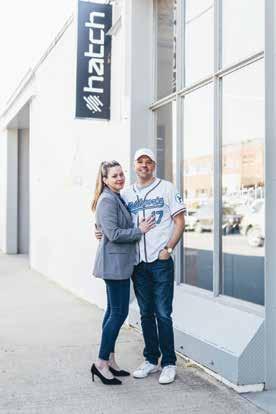


















Darko Butorac, Conductor
Get swept up in the timeless allure of cabaret. This ALT ASO program, which will also be part of Asheville Amadeus: The Art of Storytelling, will seamlessly blend classical masterpieces, timeless French standards, and more.
THURSDAY, MAY 8, 2025
7:00 P.M.
SERIES PRESENTING SPONSOR

AMBER SPONSORS
Craig Allen & Julie Cowden
Donald Gavin & Jayne Schnaars
David & Dianne Worley



BOHEMIAN SPONSORS

In 1960, you were created by a devotion to music, and the passion to share it You continue to inspire countless patrons who share that passion and devotion - and exemplify the nature of Asheville's creative spirit
Explore Asheville is honored to support your mission and talent in capturing the heart of the people of Western North Carolina and its guests. We are dedicated to shining our spotlight on the artists, makers, and musicians who help shape our community's distinct story
After all, we wouldn't be Asheville without artists like you.

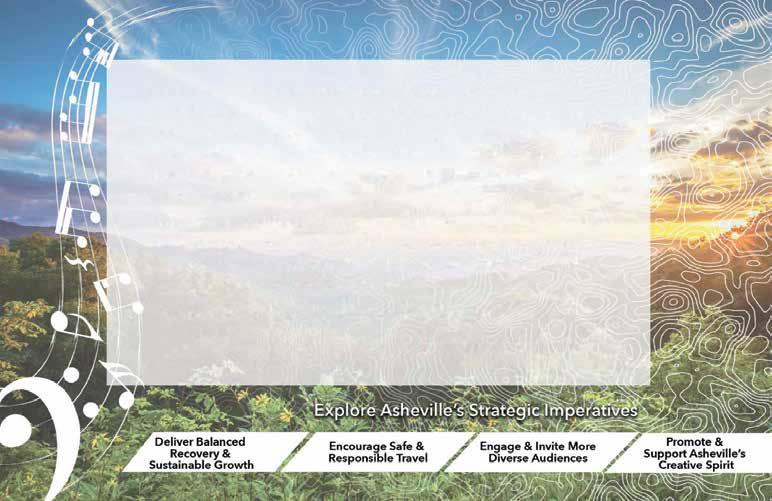
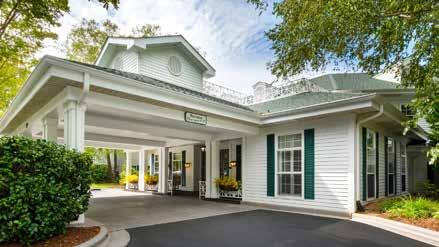

the amount of support you need to pursue the passions you desire. With programs and services to fit your needs, no matter what level of care you require. From assisted living to dedicated memory care, Arbor Terrace invites you to join the symphonic harmony that each

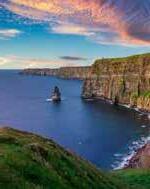



May 10, 2025 at 7:00 p.m. Thomas Wolfe Auditorium featuring ATTENTION! A narrative song cycle for extroverted mandolinist and orchestra




Acclaimed Grammy Award-winning mandolinist, singer, songwriter, composer, and MacArthur Fellow recipient of the prestigious “Genius Grant,” Chris Thile is a multifaceted musical talent, described by The Guardian as “that rare being: an all-round musician,” and hailed by NPR as a “genre-defying musical genius.” Thile is a founding member of the highly influential string bands Punch Brothers and Nickel Creek, and has collaborated with countless luminaries from Yo-Yo Ma to Fiona Apple to Brad Mehldau.
For four years, Thile hosted public radio favorite Live from Here with Chris Thile (formerly known as A Prairie Home Companion). With his broad outlook, Thile creates a distinctly American canon and a new musical aesthetic for performers and audiences alike, giving the listener “one joyous arc, with the linear melody and vertical harmony blurring into a single web of gossamer beauty” (New York Times).
Over the last year, Thile has been touring with Nickel Creek in support of the critically acclaimed 2023 release Celebrants, and captivating audiences with a playfully ambitious biographical composition entitled ATTENTION! (a narrative song cycle for extroverted mandolinist and orchestra). Additionally, he has been focused on the production of a new musical variety show, “The Energy Curfew Music Hour.” Created with Claire Coffee and featuring Punch Brothers, season one is available on Audible and all podcasting platforms. Most recently, Chris debuted a new one-man show “The Manhattan Variations” in NYC’s Little Island about finding oneself in a little cocktail bar on the Lower East Side.
Bernard Hermann
Suite from Vertigo
I. Prelude
II. The Nightmare
III. Scéne d’amour

J. S. Bach
Concerto for Two Violins in D minor, BWV 1043
Chris Thile, Mandolin
Martha Gardner, Violin
III. Allegro
Samuel Barber
Violin Concerto, Op. 14
Chris Thile, Mandolin
III. Presto in moto perpetuo
INTERMISSION
Chris Thile
ATTENTION! A narrative song cycle for extroverted mandolinist and orchestra
Chris Thile, Mandolin & Vocals
Claire Coffee, Director
1. Attention
2. Lord Starbucks
3. The Rooftop
4. Carrie Freaking Fisher
CONCERT CO-SPONSORS


Chris Thile (b. 1981)
I adore orchestras. Whether scaled up for grandeur, or down for intimacy, nothing makes me prouder to be human than hearing a stage full of highly skilled orchestral musicians practicing their craft together. It’s magic, and it’s something I’ve been desperate to participate in since the early aughts, when a hero of mine, Edgar Meyer, walked me through the score of a violin concerto he wrote for another hero of mine, Hilary Hahn. In the late aughts I wrote a
(continued on next page)
mandolin concerto, but after performing it quite a bit for a year or so with some truly lovely orchestras, I realized that it was basically the musical equivalent of fan fiction (like I’m tempted to rename it “Bartok meets Adés for coffee at Edgar’s”). SO, I went back to admiring orchestral music from afar, even as I continued to monitor my inner ear for something that might justify another attempt.
A year or two ago, a tantalizing text from my pal, Eric Jacobsen (“Thile, whatever you wanna do with orchestra, we can make it happen!”) prompted more pro-active monitoring and I started hearing bits of what would eventually become “ATTENTION!” I was confused at first, ‘cause these little aural visions included not just mandolin and orchestra, but singing AND talking as well. Whoa, ok…FUN. Further dreaming led to the conviction that there should be an actual STORY, not just loosely related vignettes (which has pretty much been my MO on long form pieces with vocals up to this point). But WHAT story? I’ve always loved writing songs based on short stories, so I started there, widened the search to essays, then read a bunch of plays, but every time I got excited about something, a nagging little voice (probably remembering my last orchestral piece) would say “Yeah, but why would YOU be the one to musicalize this story?” Ugh. Fair. Ok, fine then: what is a story I like to tell about something that happened to me that my friends seem to like hearing? Ah HA! THIS ONE, hands down, no contest. If you’ve ever had a couple rounds with me at a good cocktail bar, chances are I’ve trotted it out, and the thought of turning it into a piece of orchestral music got my inner ear cranking like never before. It’s a ridiculous story, but it’s 100% true, and the more I’ve worked on the telling of it, the more aware I’ve become of what a profound impact the whole experience had on me as a person who loves to make things and show them to other people.
You can find the lyrics at christhile.com/attention, but I recommend only using it when my diction isn’t up to snuff (I’m working on it, swear to God!). Now, if you’ll just give me your attention…
Scan this QR code to review the lyrics to Chris Thile’s ATTENTION! A narrative song cycle for extroverted mandolinist and orchestra




An Evening with Chris Thile is part of the Asheville Symphony’s biennial Asheville Amadeus Festival, returning this spring with co-headliners Chris Thile and Time for Three.
Asheville Amadeus Festival is back for its fifth iteration, Asheville Amadeus: The Art of Storytelling. The festival brings together some of Asheville’s most talented musicians, artists, creators and entertainers for 11 days of performances, education programs, collaborations and social events. Join us April 30 - May 10, 2025. For information on the festival, events and ways to get involved, visit AshevilleAmadeus.org.
PARTNERS INCLUDE










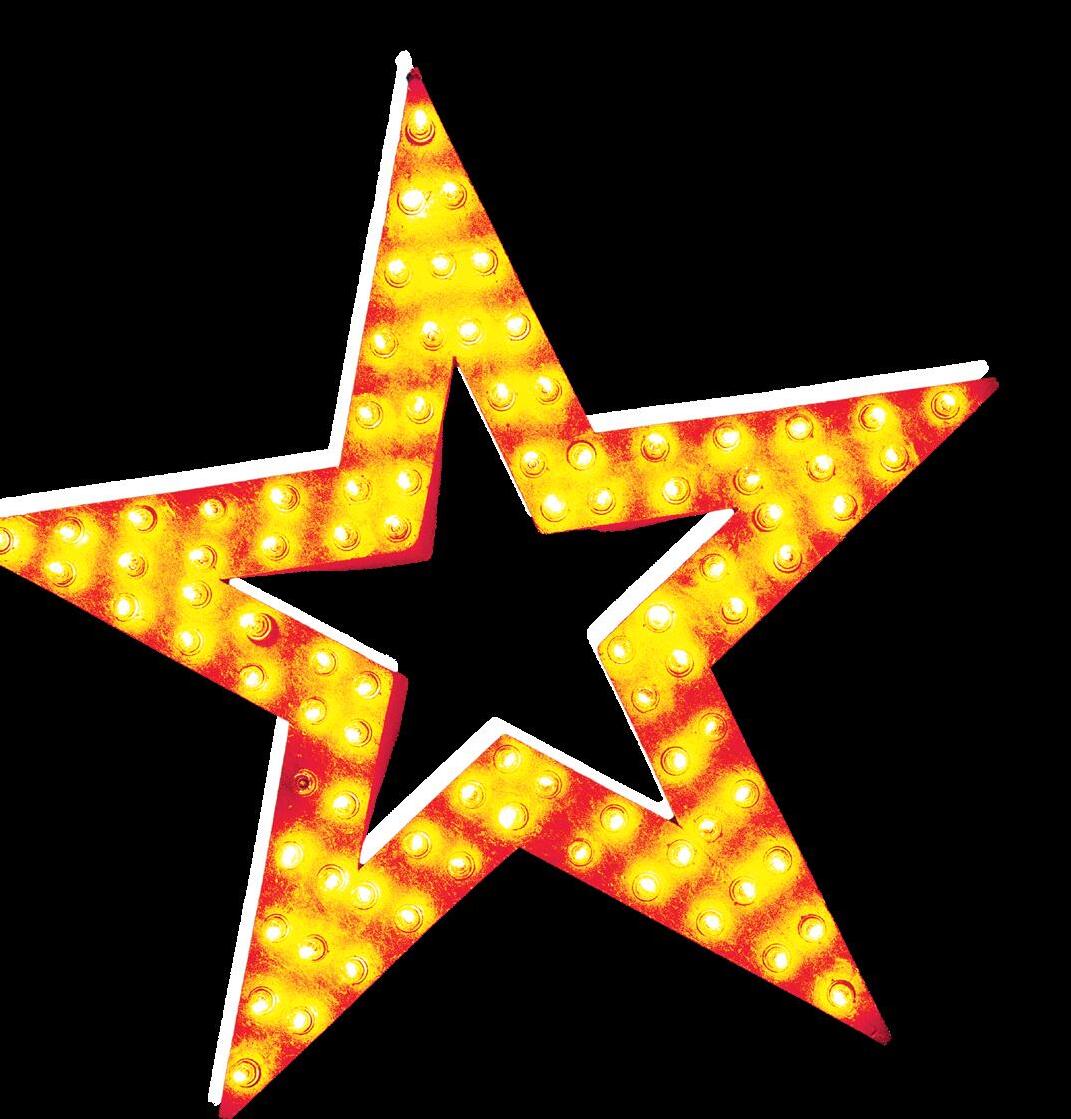



Darko Butorac, Conductor
Jonathan Christopher, Vocalist
Prepare to be dazzled as ALT ASO brings the magic of Broadway to Highland Brewing! Featuring the dynamic Jonathan Christopher, cast member of the Tony-winning 2023 Sweeney revival, this concert will offer an unforgettable evening of Broadway hits, timeless classics from the American Songbook, and beloved classical pieces.

MONDAY, JUNE 2, 2025, 7:00 P.M.
SERIES PRESENTING SPONSOR

AMBER SPONSORS
Craig Allen & Julie Cowden
Donald Gavin & Jayne Schnaars
David & Dianne Worley



BOHEMIAN SPONSORS



GOLDEN SPONSORS
Mary & Jim Kirby

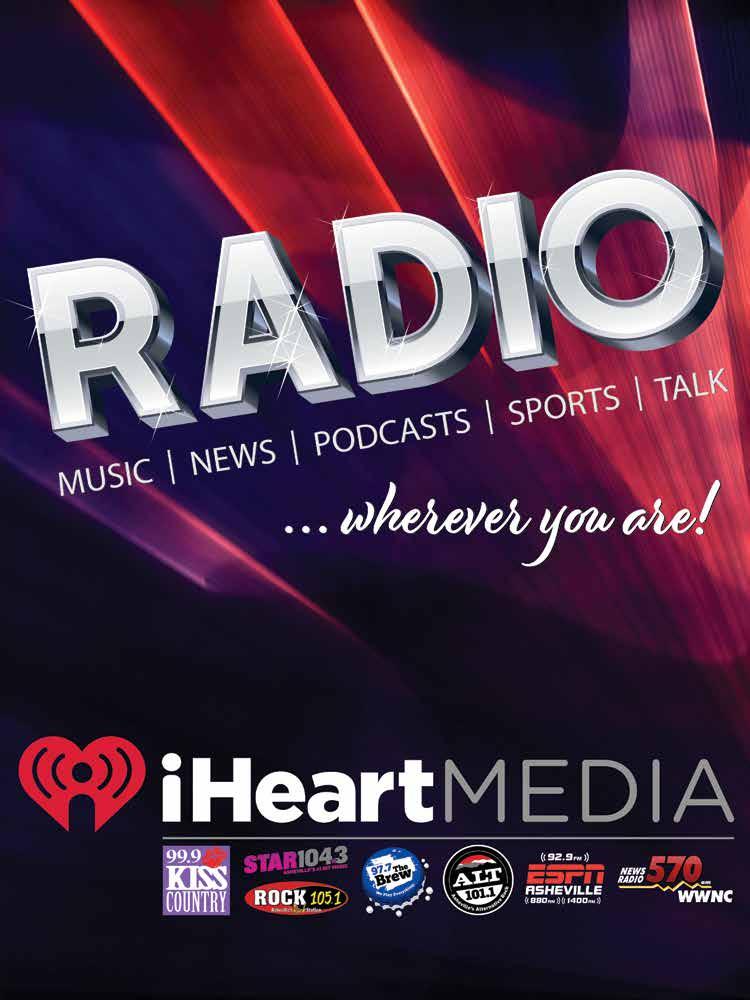





Andry-HarrisGroup atMorganStanleyPrivateWealthManagement MichaelAndry FamilyWealthDirector SeniorVicePresident PrivateWealthAdvisor
500CollegeStreet Asheville,NC28801 +1828250-8744
michael.andry@morganstanleypwm.com
https://advisor.morganstanley.com/the-andry-harris-group Insurance15850592 NMLS663185

©2024Morgan StanleySmith BarneyLLC.MemberSIPC. PWM003B CRC506752711/22CS9899356























Thomas C. Bolton
Bill & Nancy Gettys
Henry A. LaBrun
David & Pamela Lane
James S. Thompson
Michael & Catty Andry
Lynne & John Eramo
Tony McLean Brown & Kelli Darlin
Olivia & Gary Zahler
Craig Allen & Julie Cowden
Diane & Rich Byers

Donald Gavin & Jayne Schnaars
Jim & Mary Kirby
Gerry & Nancy Kitch

Ed & Cindy Towson
Travis Worl & Richard Lindau
David & Dianne Worley in memory of Katherine Armitage & Jack Jones
Dr. Bolling Farmer
Gary & Patty Coleman
Richard Schaffer & Anastasia Bartlett
George & Kathy Dambach
Adarrell Gadsden & Marcie Ownbey
Dr. & Mrs. Ralph C. Loomis
Billie Marzullo, Rhonda & Marcus Grimes, and Kathy & George Dambach






Carol & Hugh McCollum
Phil & Katie Osborn
B.A. & Gary Schenk in fond memory of “Lambo” Larry Marzullo











Dr. John & Mrs. Wendy Cuellar
Debbie Green
Paul & Liz Hosier
Mountaine Jonas
Irene & Michael Stoll
Thomas G. Tachovsky & Lynn G. Baird





Corporate and family sponsorships provide vital support through a variety of dynamic funding opportunities that enable our artistic, community outreach, and music education programs.
The Asheville Symphony is committed to providing unparalleled customer service to its corporate partners. Each sponsorship package can be tailored to meet your specific business objectives.
If your company or business is interested in sponsoring Asheville Symphony concerts, special events, or artists please call the Development office at 828.820.2520 or email development@ashevillesymphony.org to learn more about partnership opportunities and associated donor benefits.
An in-kind sponsorship is a great way to introduce your products and/or services to an upscale audience while supporting your Symphony. Needs vary from season to season but generally include such items as wine, liquor, and catering. For more information, please contact the Development office at 828.820.2520 or email development@ashevillesymphony.org.

$50
$170
Covers the music for one Asheville Symphony Youth Orchestra Honors Strings Ensemble performance
Covers the cost of orchestra folders for ten Asheville Symphony Youth Orchestra students
$375 Pays for one Music in the Schools program (one quintet, one school, one hour)
$750
$1,000
Allows us to offer one masterclass for emerging young musicians with an esteemed guest soloist
Provides tuition scholarships for two Asheville Symphony Youth Orchestra students
$1,300 Covers the purchase of music for a single Beethoven symphony
$2,500




$5,000
Covers the cost of renting and moving a concert grand Steinway piano into our venue for piano recitals
Allows for one workshop for the Asheville Symphony Youth Orchestra
$10,000 Pays the fees and travel for one guest soloist
$30,000
Covers the cost of presenting one Young People’s Concert for Asheville City’s and Buncombe County’s fifth graders




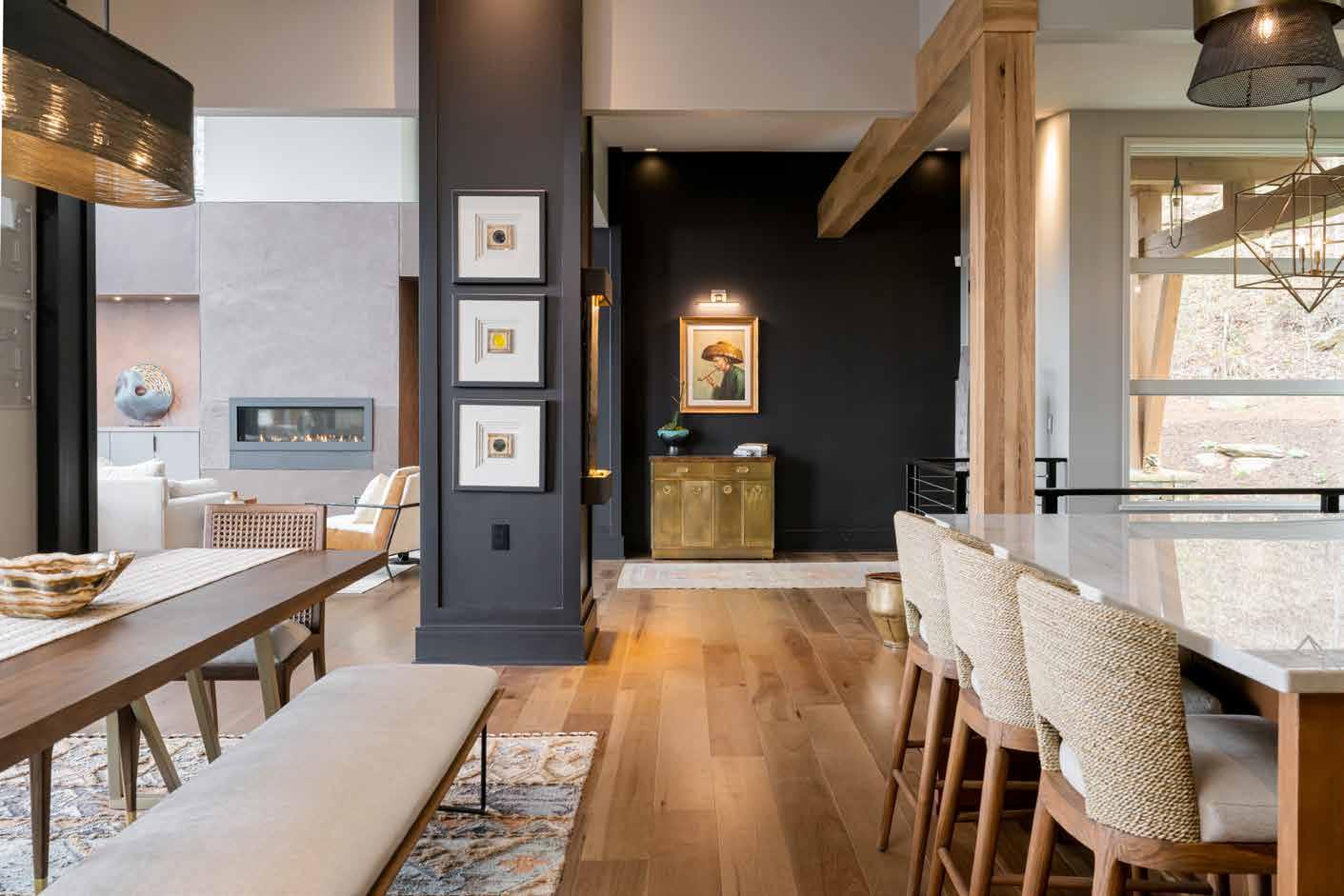
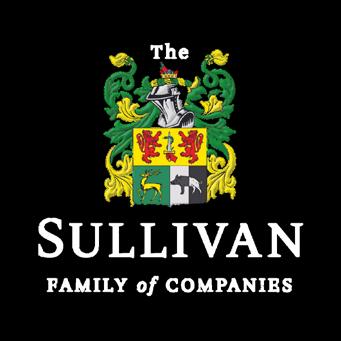





Thank you for supporting your Asheville Symphony.
Contributions to the Asheville Symphony support our artistic and educational programming — everything from the music performed on stage by our highly trained and talented musicians to the education programs our musicians implement when visiting local elementary schools.
You can choose how to direct your support:
• Annual Fund
• Sponsorship
• Asheville Amadeus Festival
• Asheville Symphony Youth Orchestra
• Music Education Initiatives
• Endowment
The following recognition encompasses contributions made from January 1, 2024 through December 31, 2024.
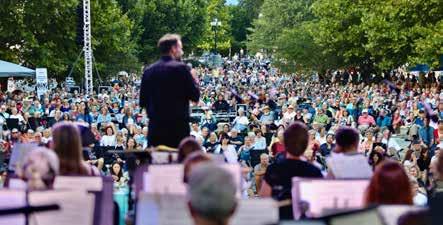
$100,000+
Ingeborg Meeke*
JoAnne Setzer*
$50,000 - $99,999
Asheville Symphony Guild
Flow Volkswagen Porsche Audi of Asheville
iHeart Media
Kimpton Hotel Arras
Drs. Joanne and Tom Parker
$25,000 - $49,999
Thomas C. Bolton
Clover CBD Dispensary
The Community Foundation of Western North Carolina
Explore Asheville
Bill and Nancy Gettys
Gerald and Nancy Kitch
Henry A. LaBrun
David and Pamela Lane
North Carolina Arts Council
The Payne Fund
Maurice and Bonnie Stone
James S. Thompson
Olivia and Gary Zahler
$15,000 - $24,999
Michael and Catty Andry
Gary and Patty Coleman
Lynne and John Eramo
Dr. Bolling Farmer
Donald Gavin and Jayne Schnaars
Givens Communities
Keith Keener
Jim and Mary Kirby
Carol and Hugh McCollum
Tony McLean Brown and Kelli Darlin
Morgan Stanley Private Wealth
Management: The Andry / Harris Team
Morgan Stanley Foundation
Penley Produce Vacation Homes
Ed and Cindy Towson
Sarah Van Gunten
$10,000 - $14,999
Craig Allen and Julie Cowden
ArtsAVL
Audrey Love Charitable Foundation
Blue Spiral 1
Rich and Diane Byers
Chaddick Foundation
George and Kathy Dambach
John and Suellyn Felker
Helle Creative
Carolyn Hubbard
Jill and Joe Lawrence
Amy Loether
Barbra and Keith Love
Bob and Martha Pierce
QC Kinetix
Jo Edda Rosskamp
Richard Schaffer and Anastasia Bartlett
Travis Worl and Richard Lindau
David and Dianne Worley
$7,500 - $9,999
Anonymous
Mary and Jack Anderson
Adarrell Gadsden and Marcie Ownbey
Hatchworks Coworking
Kathryn Theodore Travel Advisors
Dr. and Mrs. Ralph C. Loomis
McGuire, Wood & Bissette
Phil and Katie Osborn
Ralph Protsik and Susan Wolin
Roberts & Stevens, P.A.
Gary and Neesa Warlen
$5,000 - $7,499
Anonymous
Stephen Anderson and Janine Anderson-Bays
Awaken Skin & Body
The Balgley Family Charitable Foundation Bank of America
Ashley Sayre Bell
Diana Bilbrey
Buncombe County
Birch Carlson
City of Asheville
Dr. E. Brown Crosby
Dr. John and Mrs. Wendy Cuellar
First Bank
Debbie Green
Highland Brewing Company
HomeTrust Bank
The Matt & Molly Team
Ann and Jerry McLellan
Northwestern Mutual
Robert & Mercedes Eichholz Foundation
B.A. and Gary Schenk
Dr. Tony Sciara, Ph.D and Dr. Jill Vargo
Yvonne Smith
Tito’s Handmade Vodka
$2,500 - $4,999
Anonymous
Mr. and Mrs. Robert T. Bayer
Lucy and Kirk Borland
Beverly Briedis
Bill* and Clarita Burton
Linda and Tom* Bushar
Margaret Butler
Jane Christiansen*
Crawley, Lee & Company, PA
Jerry and Diane Cunningham
D.R. Horton
Nancy and Ron Edgerton
Elaine and Michael Fulbright
Clair Griffith and Geoffrey Mitchell
Rhonda and Marcus Grimes
Fred and Cindy Groce
Richard and Yolanda* Hall in memory of Rikki Hall
Paul and Liz Hosier
Bill and Kitty Hunt
Anne Jarema and Clifford Albertson
Mountaine Jonas
Margarete W. Moon Endowment of the CFWNC
Carolyn Marlowe
Mercy Urgent Care
Carol Marin, Mosaic Community
Lifestyle Realty
Amy Neel
Ann Perry
Publix Supermarket Charities
Jim Reeves
The Sabri Foundation
Bill Schulz and Odile Perrenoud
Troy Schmidt and Diane Song
Irene and Michael Stoll
Thomas G. Tachovsky and Lynn G. Baird
Walnut Cove Members Association
Alan and Kathleen Young
$1,000 - $2,499
Anonymous
Don and Nancy Ackermann Cole
Brad and Diane Arnold
David and Sydney Atkinson
Blue Mountain Pizza
William Bond and Johnny Ko
Claude and Sallie Broach
Ed and Donna Broadwell
Timothy Butts and Susan Harrington Butts
Amy Campbell
Lynne Cannady
Lois S. Carlson and Jerome Mrowca
Randy and Martha Carson
Gene and Lee Casey
Charles Clogston*
John and Jeanne Condren
Daniel and Caroline Crupi
Al and Jamye Davis
Darilyn Dealy and Lee Pagel
Jurgen and Leslie Dierks
Lori Doerr
John and Suzie Donahoe
Gregory Dray
Karen Dugas
Patricia Eargle
Richard and Bridget Eckerd
Travis Elliot
John and Marsha Ellis
Dr. Alan and Suzanne Escovitz
Susan Fisher
Betty Fox
Judy Galloway
Neil and Cindy Garroway
Anne and Kent Gatling
Peter and Jasmin Gentling
Joseph Gigliotti
Clementine Gregory
Michael J. Grillot
Dr. and Mrs. Heinz K. Grohs
Sam and Robin Harben
Dr. John Hazlehurst
Jill and Dwight Healy
Jennine Hough
Fred and Heather Hudson
Barbara and Bill Hume
Judy and John Johnston
Gail Jolley*
Suzanne Jones
Jon and Ann Kemske
Susan and David Leader
The Leever Foundation
Rita Lenderman
Nancy Lilly and Marie-Odile Froment
John and Janet Long
Sue and George Luther
Jan and Bruce Manes
Carol and Pedro Martinez
Billie Marzullo
Barbara Mueller
Nachos & Beer
Russell and Ladene Newton
Dale and Barbara Phipps
Robin T. Rutledge and Karen Keeler Rogers
Rotary Club of Asheville Foundation, Inc.
Cristian Rubiano
Susie and John Ruhl
Patrick Ryan
Wade and Mary Margaret Saunders
Dianne and Charles Sawyer
J. Howard and Honey Solomon
Gary and Jeanne Ann Stroebel
Cathy Stryker
Kelly Thompson
Jill Tourtellot
Almudena Underwood-Lema
Judith Van Horne and Stephen Hendricks
Betty Walker
Steven and Michele Warner
Bonnie Wheeler
Hank Young
$500 - $999
Anonymous
Brad and Roberta Allen
Appalachian Mountain Brewery
Susan Arnold
Dr.* and Mrs. Luther Barnhardt
Mike Bauer
Tom and Kay Beardsley
Dr. Stephen D. and Mrs. Linda B. Brown
Nan Buschmann
Georgia Case
Karen L. Cianciulli
Joel and Carole Hampton Cotter
Virginia Craig
Lynn Crystal
Sharron Davis
Mary Ellen Dendy and Aaron Dahlstrom
Kristen Dusenbery
Drs. Louis Dwarshuis and Marilyn Kolton
Bruce and Day Ann Emory
William and Carol Falender
Cary and Koni Findlay
Linda and Jeffrey Fromson
Robin and Gordon Gaiser
Mrs. Edeltraut Gilgan-Hunt
George and Elaine Goosmann
Scott and Sally Gregg
Al and Betsy Gumpert
Virginia W. Hayes
Tom and Patricia Hearron
Stan Ingber and Laura Robbins
Bill Jacobs and Susan Posey
Elizabeth Justice
Amy and John Kelso
Al and Margareta Koch
Pat and Bud Kofron
Michael Kryzanek
Tom and Dian Leeper
Ned and Jane Lesesne
Virginia and Drew Litzenberger
Chuck Lockwood and Patrick Ryan
James Losse and Ellen Haack
Dr. Linda Lutz and Gary Ticknor
Henry and Elizabeth Mainwaring
Gail and Ron Manheimer
Diane and John Martin
Robert Maxwell and Shelia Elingburg
Anna and Michael Mazur
The Patricia McCauley Charitable Gift Fund
Anne McKenzie
James H. McMillan and Carol H. Kaufman
Lucille Mueller
Shirley Oltman
Jeffrey and Lisa Owen
Julene Reese Roberts
Irene Dillingham Richards Family
Foundation
Frank Rutland
William Scarborough
Kenneth and Elizabeth Schapira
Larry and Marilyn Shames
Ann H. Skoglund
James Storey and Janice Collins
Carol and Terrence Tinkel
Kathleen Busby and Razz Waff
Linda Walker
Donna and Randy Weast
Jeff and Susie Wellington
Paul B. Williamson
Thomas Young
Gregory and Marjorie Zack
$250 - $499
Anonymous
Altura Architects
Mike* and Lorna Anderberg
David and Ann Bottomy
Elizabeth Boys
Nancy Casey
Michael Cleveland and Maria-Grazia Nunzi
Bill and Meg Clontz
Kay Dambach
Ellie Daniels
Kim Eiring
Francis Erckmann
Polly S. Feitzinger
James and Linda Focareto
Christine Glaser
Tom Gurley
William Harlan and Stephanie Carpenter
Peter Wortham Hawes
Nancy Houha
Jan Hundhausen
John and Carol Jackson
Marian and Thomas Jerdee
Ruth Sieber Johnson
Jennifer Jones and Robert Steffen
Katherine and Jon Karraker
Margaret Kelso
Elfi LaPlante
Meredith Lenell
David Miller
Martha and Thomas Mills
John K. Orr
Todd and Kaye Phillips
Donald and Brenta Poole
Pam and Rex Prosser
Donna and Edward Reigner
Vicki Richards
Barbara Robinson
David Russell
Alexandria Sanford
Nancy Schuman
Ilona and Michael Sena
Courtney Smith
Barbara and Marty Stickle
Robert Stone
Jeff Sturkey and Beth Gettys Sturkey
Agnes and Jeff Vandergrift
George Wilds and Steve Connell
Marlene and John Yokim
$100 - $249
Anonymous
Joshua Aaronson
Frances Alexander
Dennis Ash and Sarah Lashlee
Asheville Alumnae Chapter of Sigma Alpha Iota
Douglas Atchley and Lee Davis
Sally Atkins
Betsy G. Atkinson
Robert Baldwin
Viva Banzon and Robert Evans
Richard Bogner
James Bond
Doris Brooks
Allan Brown
David G. and Lin Brown
Clinton Bugg and Jeff Nucey
Lana Burns
Bob and Bonnie Busby
Elizabeth Button
Dr. Sausan Campbell
Meredith Candler
John and Gail Carpenter
Carol Carson
Grace Chappell and Patrick O’Cain
Bishop Charles and Karen Crutchfield
Gary Clark
Marcia Clarkson
Marvin Cole
Michael and Marilyn Cortes
Scott and Katherine Counce
Elizabeth Culbreth
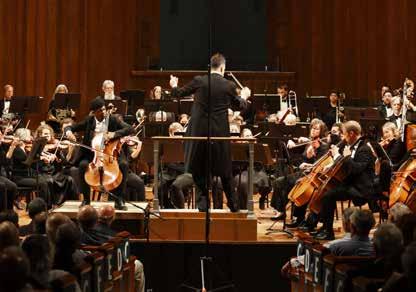
Your gift to the Asheville Symphony’s Annual Fund allows us to direct support to the area of greatest need.
The Annual Fund is the foundation of support for your Symphony. Your generosity will allow us to drive artistic collaborations with renowned musicians; enhance music education programs serving WNC kids ages 8-18; create new opportunities to experience the power of live orchestral music in unusual settings; and provide thought-provoking and inspiring programming for families, students, and audiences of all ages.
Visit AshevilleSymphony.org/Donate to make gift today.
To learn more about Annual Fund giving, contact the Development office at development@ashevillesymphony.org or call 828.820.2520.
Annual Fund Donor Benefits include:
Invitations to Patron Receptions featuring musicians, guest artists, and the Music Director ($500+ to the Annual Fund)
Access to exclusive, reserved parking section at Masterworks concerts ($1,000+ to the Annual Fund)
Priority access to purchase ALT ASO tickets
($2,500+ to the Annual Fund)
Mary Cunningham
Patti D’Angelo
Alexa and Rich Dann
Kathryn Daughton
Alan Davis
Mack Day
William N. Dorfman, Ed.D.
Erin and Tom Doyle
Amy Dragon
Martin and Ivy Dyckman
Julie Eckelbarger
Linda Engwell
Edward and Amy Euler
Stephen and Jackie Finstad
Deborah Francis
Ellenor Frelick
Jennifer Garnett
Mary Goodkind
Margery Greene
Amanda Hall and Robert Zeid
Dot and Wade Hampton
Gail Harris and John Boneparth
Richard Henderson
Phil and Jolene Hocott
Toby Hollenberg
Joel Horwich
Michael and Laura Hoskins
Charles Hudson
Steve and Nancy Hurst
Ralph and Sheryl Husby
Lisa Huxley
Christa Hyatt
John and Jill Hyman
Tom and Libby Irwin
Thorunn Ivey
Mindy Jaffe
John and Karla Jalocha
Susan Jensen and Lew Gelfond
Vinod Jindal

You’re the reason the Asheville Symphony is able to share exhilarating performances.
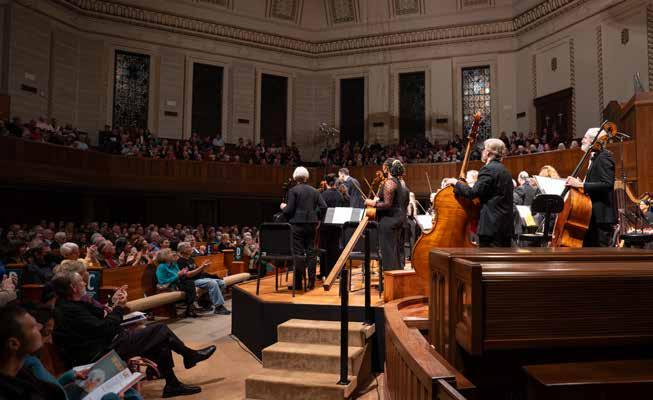
Your ticket and subscription mean the world to us. But did you know that tickets and subscriptions cover less than 35% of our operating costs? Donations to the Annual Fund make up the difference. Thank you.
Gayle Petty-Johnson
Walter and Anne Justice
Jess and Phyllis Key
Ann Batchelder and Henri Kieffer
Arthur Kirby
Karen Lachow
Rebecca Lance
Eric and Mala Lapp
Lynn Lederer and Leslie Long
Jeffrey Linzer
Alan Lipsky and A.J. Rhodes
Rev. Alexandra Lusak
Shane and Sarah Lympany
Suzanne and Jay Mahler
Margaret McAlister
Jerry McAninch
Glenda H. McDaniel
Amy McGuire and Brian Wallace
Elwood and Margaret Miles
Gina and Dale Nelson
Rita Nilsen and Carl Brickman
Francis Nullet
Eric and Lynn Ordnung
Lori Oxford and Alberto Centeno-Pulido
Betty J. Paine
Nicole Pasternak
Joseph Piccolo
Cynthia Pierce
Jack and Susan Pierce
Kathleen Quinlan and Marc Parham
Mary Racek
Lynnell W. Reese
Terry and Sarah Reincke
Michelle Rippon
Don Roberts
John and Pam Roeth
Sherree Roller and David Janson
Evan and Susan Rosenberg
Carol Rosenblum
Dorothy Sagel
Salt Face Mule
Bob Sarabia
Barbara Schrader
Frie and Liz Schulz
Stephen Sedgwick
Jane and Edward Smith
Dave and Sue Snook
Gail and Nelson Sobel
Thomas and Christena Southwick
Beth Stickle Schoenheit
Paul Stroebel
Kenny Sudnik
John and Mary Tadey
Janet Thatcher
Matthew and Sarah Volk
David Walters
Mariana G. Warner
Raymond Watkins
Susan and Don Watson
Norman and Janet Weeks
Robert and Joyce Weinberg
Sue and Robert White
Calvin and Susan Willis
Wellford Wilms
Larry and Janie Wilson
Barbara Witt
$1 - $99
Evan Agee
Alicia Albee
Max and Lillian Alexander
Brandi Andrade
Jennifer Aregood
Pauline Aridas
Devin Asaro
Jannice Ashley
Mary Ault
Anne Babcock
Shannon Baggett
Kathy Baker
Jeff and Elizabeth Baker
Eric Bank
Grace Bartlett
Michael Bashaw
Sylvia Bassett
Rush Battle
Robert Becker
Marty and Barbara Beckerman
Joseph and Sophie Beckham
Kathy Bellizio
John Bickart
Mark Bigelow
Diego Blanc
Adlai and Karen Boyd
Diana Brewster
Elizabeth and Kemper Brown
Chris Brownback
Rebecca Bruce
Nancy Buchanan
Sarah Cayson
John Chapman
Karen Clarke
Memphis Clayton
Sarah Cochran
Samuel Coley
Douglas and Lousia Combs
Harriet Cone
Patti Corozine
Debra Cowan
Karen Cowman
Vickie Cox
Debra Crabtree
Adrienne Crowther
Tala Dajani
David Daniels
Matthew Daughtry-Grubbs
Gerald Davies
D. Davis
Johnny Davis
Roger and Janese Derrough
John Dickson
Tom Doebber
Karen Doerr
Andrew and Jennifer Dukowicz
Mignon Durham
David Eads
Diane Edwards
Gaynor Eisenberg
Kyle Eliason
Jane Elliot-Hughes
Nancy Sue Ellyson
Deborah Engelkemier
Dale England
Don and Joy Erbes
Charles Erde
Carolyn Estes
Maria Eugenia Jael Vela Tijerina
Laura Fackler
Rachel Fagan
Linda Fallowes
Steve Felix
Shawn Feurer
Linda Flack
Douglas Flemons
Karen Fulmer
James Gatto
Jacob Gearhart
Kathryn German
Martha Gettys
Lynn Gilliland
Thomas Golden
Chowdhary Gondy
David Good
Jessie Goodwin
Susannah Gopalan
Susan Grabel
Barb Graff
Michael Groothuis
River Guerguerian
Carolyn Guthrie
Teresa Hammack
Mark Hardy
Ryan Harris
Michael Hartz
Brandi and Todd Henson
Summer Hettinger
Fredia Higgins
Gene Hill
Dennis Hillier
Carey Horne
Amanda Hughes
John Inman
Robin James
Stephanie James
Javier Jasminoy
Edward Joffe
Seth Johnson
Beth Juliar
Ruthanne Kah
Richard Kania
John Kapitan
Will and Jennifer Kaylor
Christopher Keene
Deborah Kenney
Dr. Donna Kerr
Jennifer Knox
Sandy Konkel
Alan Kotch
Taisiia Kovbasenko
Judith Kramer
Margaret Krusch
John Lang
Wendy Lapidus
Matthew Larkin
Walter Leginski
Bruce Leonard
Jeremy and Susan Lerner
Elizabeth Levitas
Debra Liles
Erynne Liniker
Arthur Litowitz
Gregory Lomas
Kathryn Long and Axel Graumann
Will and Diane Lopez
Beatriz Lothrop
Rudsel Lucas
Margie Mahan
John and Elaine Maimone
Gerald Malsbary
Robert Manasse
Gary Mannies
Ana Margarita Cebollero
Canter Martin
Dallas Martin
Adam Matar
Rose Mathis
Josh Matz
Barbara Mayer
Bill McClain
Carol McCrory
Michael McDermott
Manuel* and Karen Medeiros
Goitzen Meindertsma
Michael Miale
Nancy Miller
Hanne Miska
Lori Mitchell
Laura Mitchell
Julie Modaff
Nathanael Moretz
Frank Moretz
Alan Morgan
Elaine Muller
Joanne Neary
Aaron Nichols
Thomas Norman
Milena Orchard-Hays
Theresa Oscarson
Jennifer Ostendorf
Rebecca Pace
Richard Paul
Many companies offer a matching gift program for employee (and retiree!) charitable donations — this can double or triple your gift! Thank you to the following companies who have recently matched donor gifts:
AIG
Bank of America
Boeing
Steelcase Foundation
Shell Oil Company Foundation
Sue Ann Pinger
Dorothy Porter
Jon Prater
Caryn Preston
Rachel Raab
Philip Ramsey
Janet Randolph
Ryan Rapsys
Gail Reagan and Jim Graham
Dan Richards
Andre Richison
Billy Robinson
Michael Robinson
Jason Rodrigue
Stephanie Rosener
James Rowal
Christopher Rupp and Karine Rupp-Stanko
S.H. Burgess, Inc.
Larry Schadler
Wade Scheuritzel
Jan Schochet
Katherine Schofield
Jonel Schuster
Gary and Lillah Schwartz
Richard and Eula Shaw
Sara Shea
Mark Sheppard
Michael Sierra
Robert Sihler
Ronald Smart
Every effort has been made to ensure the accuracy of this list. If you believe that an error or omission has occurred, please call 828.820.2520 or send an email to development@ashevillesymphony.org
Carl Smedberg
Christine Smith and Jim Duffy
Christina Sobin
Mikki Sodergren
Harold Southern
Jeremy Spurlin
Ann Squire
Courtney Stephens
Fabienne Sterckx
Jill Stevenson
Rachel Sudnik
Marcus Thompson
Adi Toth
Lacey and Brandon Townsend
Dale Twomley
Eric Warncke
John Warner
Margaret Watson
Virginia Weaver
Natalya Weinstein Miller
Jennifer Westbrook
Terence Whitt
Richard Wilfong
Jay Williams
Bob and Mary Williamson
Laura Williamson
Susanne Willis
Lauren Ross Wilson
Mathew Winer
Tom Winsch
Jackie Wintle
Wooju Yang
Sarah Yamada
John Yuder
*Denotes Deceased
In memory of Jack Jones and Katherine Armitage
Diane and Rich Byers
In celebration of Asheville and WNC Community after Helene
David and Sydney Atkinson
In celebration of the Asheville
Symphony Youth Orchestra
Judith Van Horne and Stephen Hendricks
In memory of Dr. John “Spencer” Atwater, Jr.
Julie Eckelbarger
In memory of Luther Barnhardt
Carol and Hugh McCollum
In honor of Bob and Audie Bayer
Mack Day
In memory of Chuck Briedis
Beverly Briedis
In honor and memory of
Clarita and Bill* Burton
Tony McLean Brown and Kelli Darlin
In memory of Thomas Bushar
Gary and Patty Coleman
Susan Grabel
Vinod and Manju Jindal
Irene and Michael Stoll
Calvin and Susan Willis
In memory of Gordana Butorac
Irene and Michael Stoll
In memory of John B. Campbell
Amy Campbell
In memory of Porter Claxton
Robert Baldwin
In honor of Daniel Crupi
Dale and Barbara Phipps
In honor of Sharron Davis
Mindy and Irvin Jaffe
In memory of my father
Dr. Sausan Campbell
In memory of Don Galloway
Judy Galloway
In Celebration of Big G on his 70th Birthday!
Joel and Carole Hampton Cotter
In honor of Bill & Nancy Gettys
Jeff Sturkey and Beth Gettys Sturkey
In memory of Yolanda Hall
Richard Hall
In memory of our son Rikki Hall
Richard and Yolanda* Hall
In memory of Linda Medeiros
Manny and Karen Medeiros
In honor of Frederick Mitchell
Hudson II
Charles Hudson Household
In memory of Doug Johnston
Kathy Baker
In honor of Mary and Jim Kirby
Arthur Kirby
In celebration of Charlie Lance
Rebecca Lance
In honor of Felix and Betty
Gayle Laughlin
Mack Day
In fond memory of “Lambo”
Larry Marzullo
Billie Marzullo
Rhonda and Marcus Grimes
Kathy and George Dambach
In memory of Alexander McKinney, MD
Ned and Jane Lesesne
In memory of Manny Medeiros
Irene and Michael Stoll
In memory of Ingeborg Meeke
Irene and Michael Stoll
In honor of Katie and Phil Osborn
Barbara Schrader
In honor of Jason Posnock
Patrick Ryan
In honor of Darko Butorac and Mikki Sodergren
Toby Hollenberg
In honor of Charlie B. Turner
Christine Glaser
In honor of Christpher Underwood
Almudena Underwood-Lema
*Denotes Deceased

This is one of the best ways to invest in the future of kids in Asheville and what music can do for them. It’s a legacy that will have benefits far beyond our lifetimes.
JOHN CUELLAR Legacy Society Member & Board Member
When Dr. John Cuellar attended the Asheville Symphony’s performance of Carmina Burana several years ago, little did he know that it would lead to an on-going, years-long commitment to the symphony. Awe-struck by the performance, he called the Symphony office the next morning and purchased season tickets. He has subscribed ever since.
John’s love for classical music was instilled in him as a child, attending concerts with his mother in Texas. “We weren’t wealthy, and music lessons were beyond our budget, but my mother loved classical music,” he recalls. “Hearing amazing musicians as I grew up made a lasting impression on me. I’ve had the good fortune to see and hear wonderful symphonies and performances across the country since.” John’s passion continued with the Asheville Symphony after his move here.
At one particular Asheville Symphony Annual Meeting, John stood up and spoke, sharing his admiration for the organization’s exceptional music and leadership, “The quality and musicianship in a city of this size was striking.” Shortly after, board member Jack Anderson invited him to lunch along with Steve Hageman, then executive director, and John was asked to join the Asheville Symphony’s board.
“Since then, I’ve seen the Symphony thrive under incredible leadership,” he says. “It’s a real pleasure to be part of something so inspiring and impactful.”
For John and his wife Wendy, that outreach is personal. Their daughter found her own connection to music at Asheville High School, and then on to the Asheville Symphony Youth
Orchestra, playing bassoon. “Music became her community,” John explains. She went on to study Music Therapy at Appalachian State University and now works as a music therapist at a children’s hospital. Seeing firsthand how music shaped their daughter’s life led John and Wendy to think about the future.
“The developmental data on children who play music is impressive, and we’ve seen firsthand what music can do for kids,” he shares. “It motivates them, teaches them skills they can carry throughout their lives, and creates opportunities they might not otherwise have.”
As members of the Asheville Symphony Legacy Society, John and Wendy know their gift will help sustain the Symphony for years to come. These contributions often support the Symphony’s endowment, providing vital resources and ensuring the Symphony’s excellence endures. “This is one of the best ways to invest in the future of kids in Asheville and what music can do
for them,” John says. “It’s a legacy that will have benefits far beyond our lifetimes.”
The Asheville Symphony Legacy Society recognizes individuals who make planned gifts to the Symphony.
Members enjoy unique benefits, including special events and educational opportunities, as well as acknowledgment in the season program. Please visit the following page to see Legacy Society members.
For John, the decision to give was simple. “Live music played by a full orchestra is such a rare and special experience. To sit in a concert hall and hear music that has been cherished for centuries is both invigorating and profoundly moving,” he reflects.
“Ensuring that experience continues for others is something I’m proud to be part of.”
For more information about the Asheville Symphony Legacy Society and how you can make a difference, contact the Development team at development@ashevillesymphony.org or 828.318.8181.


Dorel Abbott*
Don and Nancy Ackermann Cole
Jack Jones and Katherine Armitage*
Mr.* and Mrs. Stephen Barden III
Dr.* and Mrs. Luther Barnhardt
Mary and Leland Bartholomew*
George* and Diana Bilbrey
Marion Bleyler*
Mr. and Mrs.* Thomas C. Bolton
Joyce Bost Hogan*
Mrs. Charles Butler*
Ken and Alma Chatfield*
Barbra and Beirne Chisolm*
Jane Christiansen*
Mr. and Mrs. Gary Coleman
Nancy Crosby
Dr. and Mrs. John Cuellar
Robert DiDiego
Lori Doerr
Mr. and Mrs. David Dolan
Drs. Joyce and Lawrence* Dorr
Mrs. C.H. Elmslie
Robert and Jeane* Etter
Dr. Linda Sokalski Farrell
Dr. Bolling Farmer
Francis Fee
The musicians of the Asheville Symphony Society, Inc., are the lifeblood of your Symphony: uniting our community, lifting hearts, and inspiring with the power of orchestral music. By making a Legacy Society pledge to the Endowment during your lifetime, you are demonstrating a commitment to the Asheville Symphony’s musicians today and our vibrant future.
For more information about joining the Legacy Society and supporting the Endowment (including naming opportunities), contact the Development office by emailing development@ashevillesymphony.org or calling 828.318.8181. If you have already included the Asheville Symphony in your estate plans, please let us know so that we may include you on this list and recognize your generosity.
Doris Kistler and Fred Wightman
William and Nancy Gettys
Lindley Garner* and Mary Goodkind
Mr. and Mrs. George Goosman
Michael J. Grillot
Paula J. Grillot
Mr. and Mrs. Steven Hageman
Dr. and Mrs. Matthew Hahner
Eleanor Hall*
Dick and Yolanda* Hall
Virginia and Emmet* Hayes
Anna and Anthony* Hayward
Carolyn L. Hubbard
Bill and Kitty Hunt
Bill Jacobs and Susan Posey
Pat and Doug* Johnston
Mountaine Jonas
James Laird*
Christine Longoria
Dr. and Mrs. Carlo Mainardi
Mabel Marlsbury*
Mr. and Mrs. Arthur Mattson*
Carol and Hugh McCollum
Ann and Gerald McLellan
Manuel* and Karen Medeiros
Ingeborg and Kenneth Meeke*
Fred Meyer
Russell and Ladene Newton
Arch and Zeffie Nichols*
Mr. and Mrs. David Pheil
Mary L. Powell Education Fund in memory of Beatrice Wells
Monte Richardson*
Ernest Rosenau*
Dr. and Mrs. Joel Rosenberg
William* and Carole Roskind
August Schmidt*
Jill Vargo and Tony Sciara
John Schuler*
JoAnne Setzer*
Robert Sorton
Bonnie Stone
Norretta L. Taylor*
Edna Thompson*
Mr. and Mrs. Ed Towson
Sarah Van Gunten
Albert and Lucia Ward*
Eleanor Weil Schulmon*
*Denotes Deceased



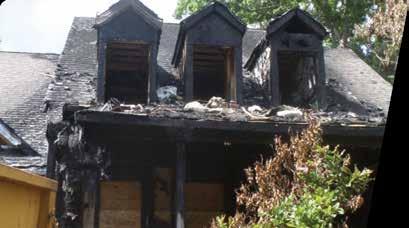
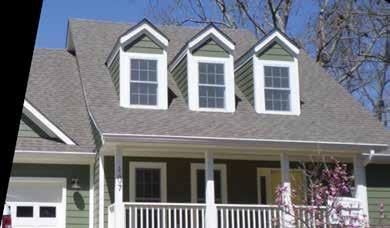




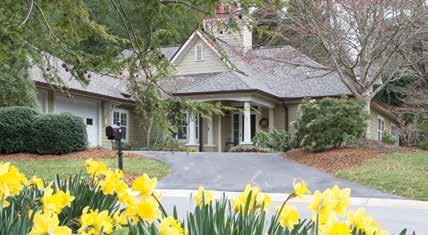



Brevard offers the best of small town living with the conveniences of a modern city. Rich in natural beauty, cultural heritage, and social amenities, Brevard is a wonderful place to call home.
A Relaxed Lifestyle A Vibrant Music and Art Scene
World-Class Fly Fishing Extensive Hiking and Biking Trails Pisgah National Forest
DuPont State Forest Gorges State Park Headwaters State Park
Brevard Music Center Brevard College The Paul Porter Center For The Performing Arts
the
in
For Over 45


Locations in Brevard, Lake Toxaway/Sapphire, and Highlands 10 Park Place West | Straus Park | Brevard, NC 28712 828-883-9895 | 800-634-5196 | Info@FisherRealtyNC.com 17527 Rosman Highway | Sapphire, NC 28774 | 828-966-9290 30 Pinecrest Road | Highlands, NC 28741 | 828-482-4503



Bringing world-class chamber music to WNC for over 70 years


Goldmund Quartet
Friday February 28 7:30 p.m.
Schubert, Haydn, Grieg Aspen String Trio
Friday
April 4 7:30 p.m. Strauss, Klien, Beethoven


Isidore String Quartet
Friday May 2 7:30 p.m.
Mozart, Schulhoff, Dvořák

The Asheville Symphony Youth Orchestra (ASYO) is Western North Carolina’s premier orchestral training program, serving nearly 200 students ages 8-19.
With two string orchestras, two full orchestras, a beginner string class, a percussion ensemble, and various honors chamber groups, there’s an ensemble for every instrument and experience level.
Throughout the year, ASYO students have the chance to participate in masterclasses, retreats, and workshops, where they learn from professional musicians and guest artists alongside some of the best music educators in Western North Carolina. Through the ASYO, students grow as individuals, learn to work together as an ensemble, and gain everyday skills like perseverance, hard work, planning, self awareness, creativity, self evaluation and goal-setting.
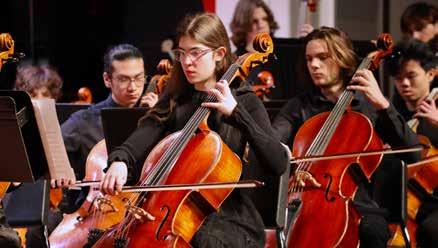
Experience these talented young musicians at one of their performances this season.
SPRING CONCERT
May 5, 2025 at Asheville High School Auditorium
Featuring Time for Three as part of the 2025 Asheville Amadeus Festival. See pages 56-70 for more details on the festival.
Concert dates and times are subject to change. For more information, please visit AshevilleSymphony.org.
Tyson Hamrick
ASYO General Manager
ADMINISTRATIVE STAFF
Rodney Workman Site Coordinator
Mika Hood Operations Coordinator
Jason Posnock Advisor
Cara Jenkins Advisor
Cynthia Roop Advisor
TEACHING STAFF
Dr. Alexandra Dee
Music Director, Youth Philharmonic & Concert Conductor
Amanda Tant
Sinfonia Conductor
Ashlee Booth Divertimento Conductor
Cady Robison
Overture Class Conductor
SPRING AUDITIONS
May 29 - 30, 2025: Winds and Percussion
May 31 - June 1, 2025: Strings
For more information, email jthamrick@ashevillesymphony.org or visit AshevilleSymphony.org/ASYO.
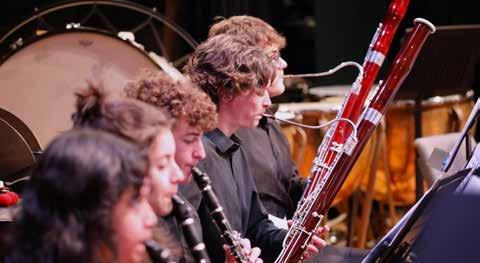
Dr. Brian Tinkel Percussion Director
Dilshad Posnock
Woodwind Coach, Honors Chamber Ensemble Coach
Franklin Keel
Strings Coach, Honors Chamber Ensemble Coach
Dr. Jason Slaughter
Brass Coach, Honors Chamber Ensemble Coach
Jared Dunn
Honors Percussion Coach
William Pooser
Honors Percussion Coach
A special thank you to Drs. Joanne and Tom Parker for their generous support of the ASYO this season. Their financial support will positively enhance music education for hundreds of students across Western North Carolina by providing scholarships, access to instruments, and unique experiences.
Tuition covers less than half of the ASYO’s operational costs.
Your gift empowers students to participate in performances, special workshops, retreats, masterclasses, and touring performances regardless of their economic circumstances.
Visit AshevilleSymphony.org/friends-of-theasyo to donate online today.
$25,000+
Drs. Joanne and Tom Parker
$15,000 – $24,999
Keith Keener
$5,000 – $14,999
Lynne and John Eramo
Gerald and Nancy Kitch
$2,500 – $4,999
Thomas C. Bolton
Jerry and Diane Cunningham
Bill and Nancy Gettys
David and Pamela Lane
$1,000 – $2,499
Michael and Catty Andry
Diana Bilbrey
Blue Mountain Pizza
Gene and Lee Casey
Clover CBD Dispensary
Dr. John and Mrs. Wendy Cuellar
Bill and Kitty Hunt
Jim and Mary Kirby
Henry A. LaBrun
Jill and Joe Lawrence
Susan and David Leader
Barbra and Keith Love
Nachos & Beer
Patrick Ryan
Donald Gavin and Jayne Schnaars
James S. Thompson
Ed and Cindy Towson
Sarah Van Gunten
Steven and Michele Warner
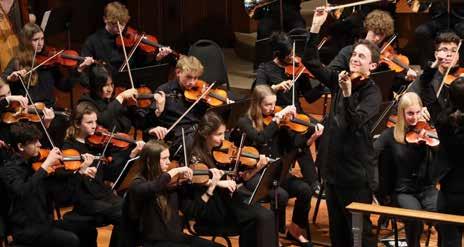
$500 – $999
Mary and Jack Anderson
Appalachian Mountain Brewery
Bill* and Clarita Burton
Jon and Ann Kemske
William Scarborough
Carol and Terrence Tinkel
Thomas Young
$250 – $499
Anonymous
Nancy Casey
Cary and Koni Findlay
Al and Betsy Gumpert
Gail Jolley*
Carol and Hugh McCollum
Bonnie Wheeler
David and Dianne Worley
Olivia and Gary Zahler
$100 – $249
Anonymous
Mike* and Lorna Anderberg
Dennis Ash and Sarah Lashlee
Asheville Alumnae Chapter of Sigma
Alpha Iota
Beverly Briedis
Dr. Sausan Campbell
Georgia Case
Gary Clark
Virginia Craig
Daniel and Caroline Crupi
Kim Eiring
Polly S. Feitzinger
Betty Fox
Ellenor Frelick
Jennifer Garnett
John and Jill Hyman
Susan Jensen and Lew Gelfond
Rebecca Lance
Alan Lipsky and A.J. Rhodes
Sue and George Luther
Margaret McAlister
Joseph Piccolo
Donald and Brenta Poole
Kathleen Quinlan and Marc Parham
Terry and Sarah Reincke
Vicki Richards
Barbara Robinson
Dorothy Sagel
Salt Face Mule
Dave and Sue Snook
J. Howard and Honey Solomon
Irene and Michael Stoll
Paul Stroebel
$1 – $99
Anne Babcock
Shannon Baggett
Karen Cowman
Erin and Tom Doyle
Andrew and Jennifer Dukowicz
Robin and Gordon Gaiser
Tom and Libby Irwin
Deborah Kenney
Jeremy and Susan Lerner
Gail and Ron Manheimer
Manuel* and Karen Medeiros
Laura Mitchell
S.H. Burgess, Inc.
Jill Stevenson
Matthew and Sarah Volk
Bob and Mary Williamson
Laura Williamson
Lauren Ross Wilson

These scholarships have been created to assist ASYO students with tuition, ensuring that all students have equal access to the best musical training and resources that Asheville has to offer. Thank you to all of our generous donors!
Philharmonia Scholarship
Given by Keith Keener
Drs. Joanne and Tom Parker Scholarship Fund
Given by Drs. Joanne and Tom Parker
Terrence and Carol Tinkel Scholarship Fund
Given by Terrence and Carol Tinkel


APPLAUDS THE ASHEVILLE SYMPHONY






OCTOBER 11, 2024
OPENING NIGHT with The Sphinx Virtuosi Chamber Orchestra
NOVEMBER 7, 2024
Raphaël Feuillâtre–Virtuoso Guitar
DECEMBER 5, 2024
Handel’s Messiah
DECEMBER 14, 2024
Kruger Brothers–In The Holiday Spirit
FEBRUARY 20, 2025
Soprano Larisa Martínez in Concert
MARCH 13, 2025
A ST. PATRICK’S DAY CELEBRATION with Dervish
APRIL 8, 2025





Pianist Zlata Chochieva in Recital
MAY 13, 2025
SEASON FINALE with Roberto Díaz, Peter Wiley, and The Erinys Quartet R ap
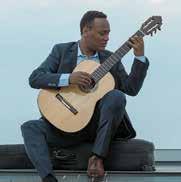






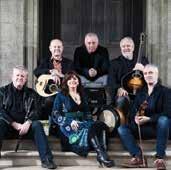
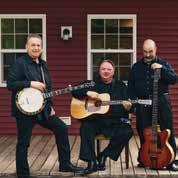



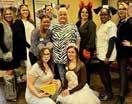










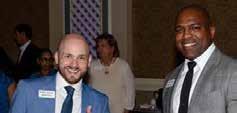

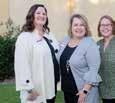
even

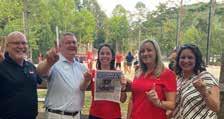


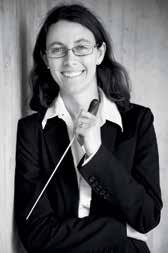

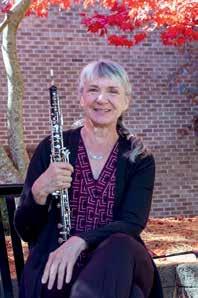



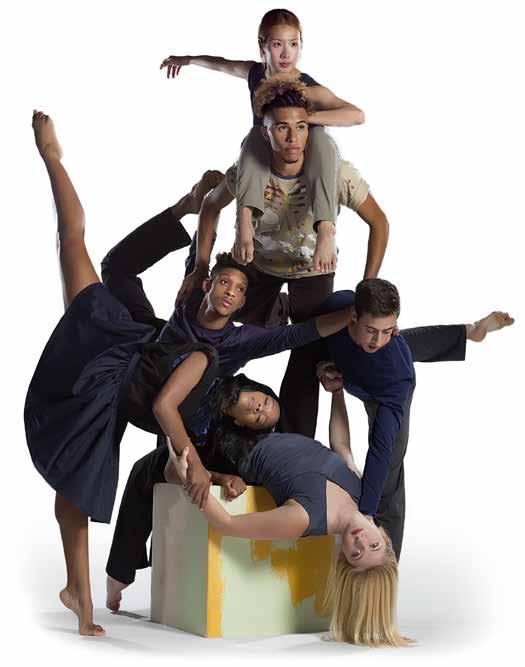







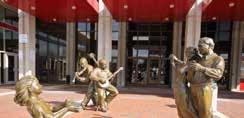








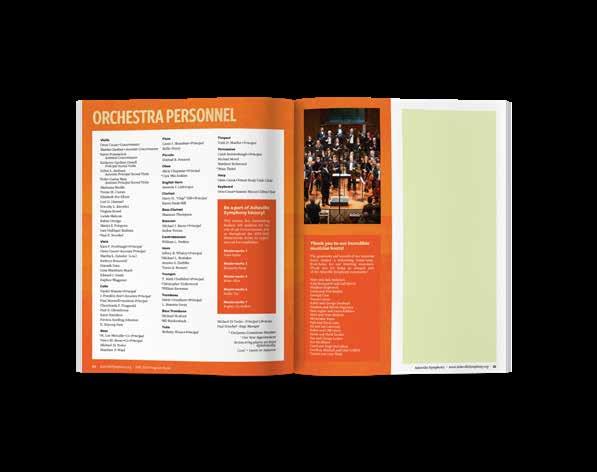

Asheville based, real estate focused private debt fund serving the Carolinas










What Is ALFIE? ALFIE is a private debt fund established in 2015. Based in Asheville, NC, our fund works by pooling investor capital to provide short term construction and bridge loans to builders, developers, and real estate entrepreneurs in NC and SC.
How Does ALFIE Fit My Portfolio? An allocation to ALFIE can complement a traditional stock and bond investment portfolio. Our historically consistent returns have a low correlation with other investment options.




